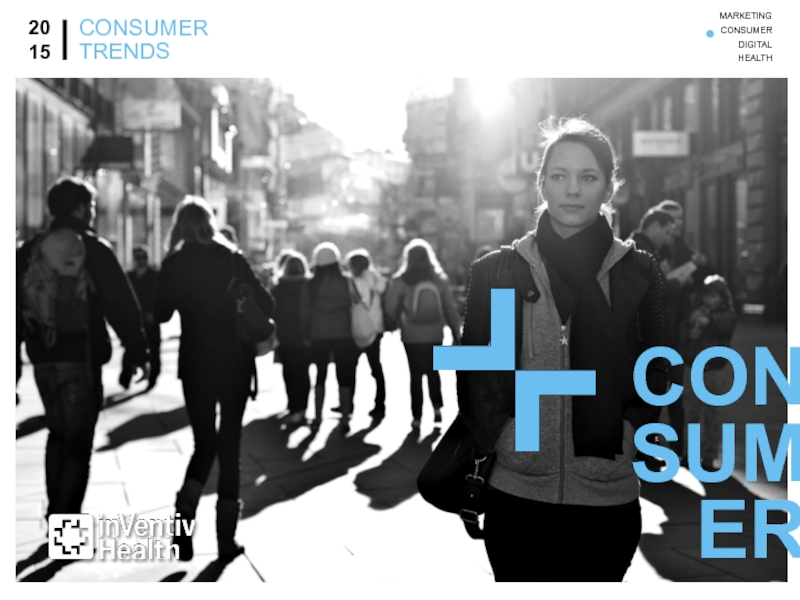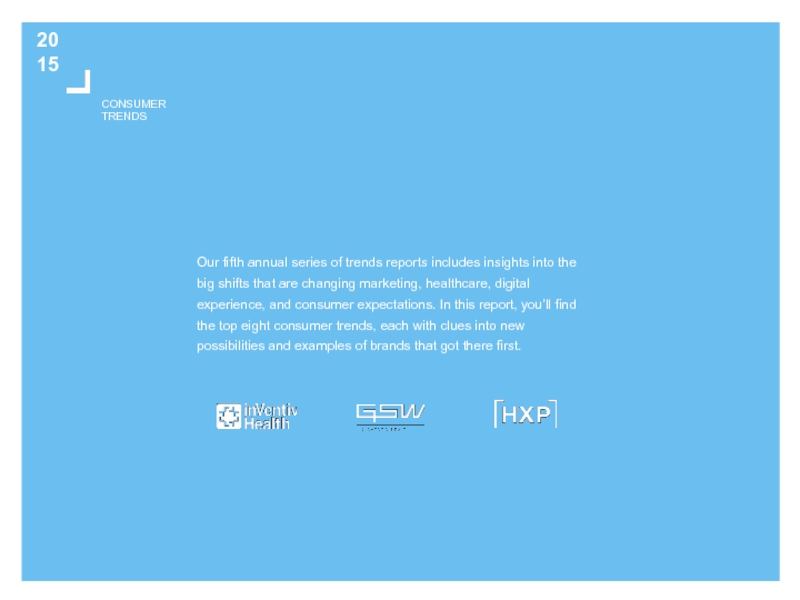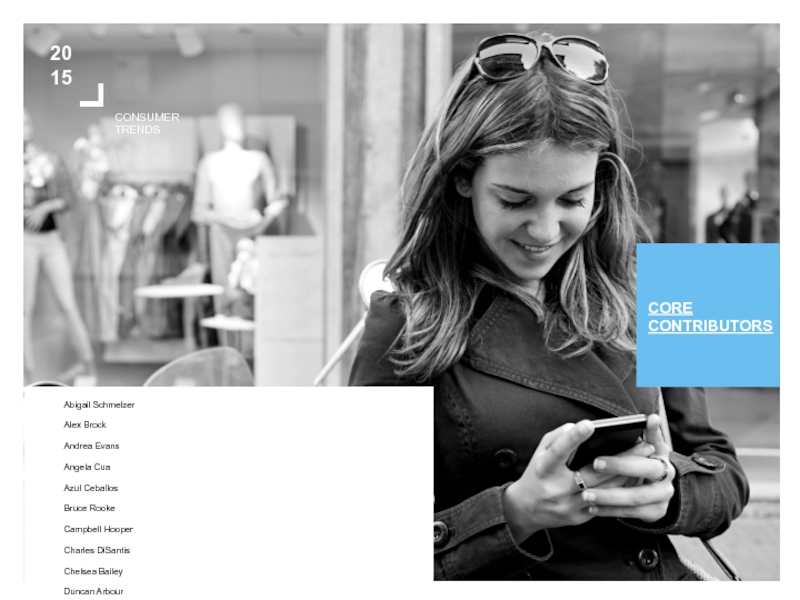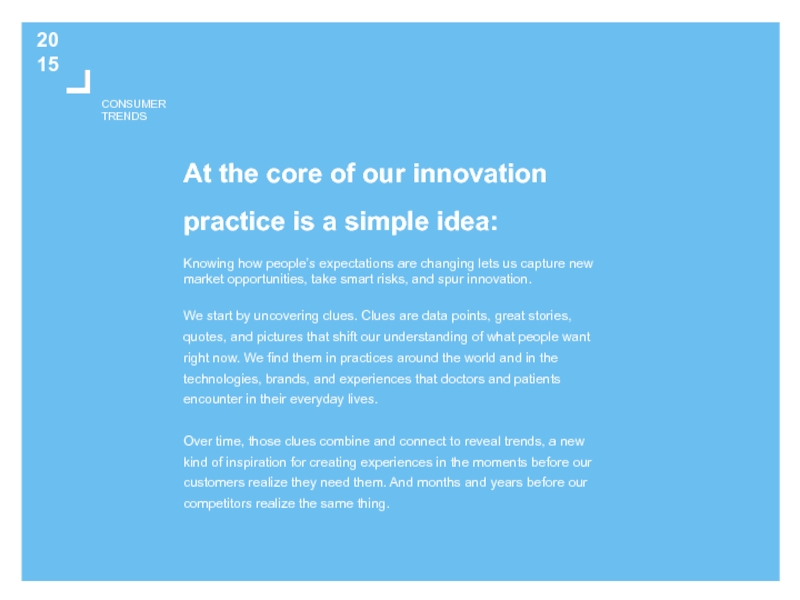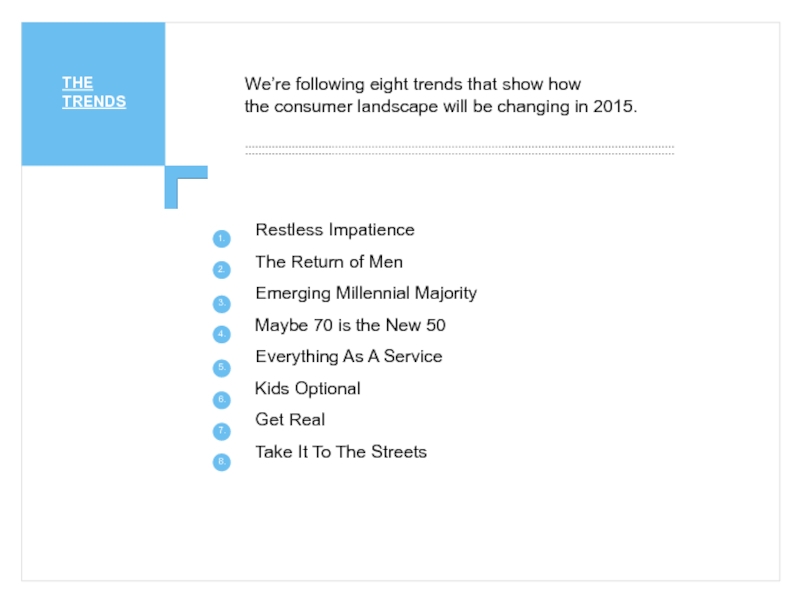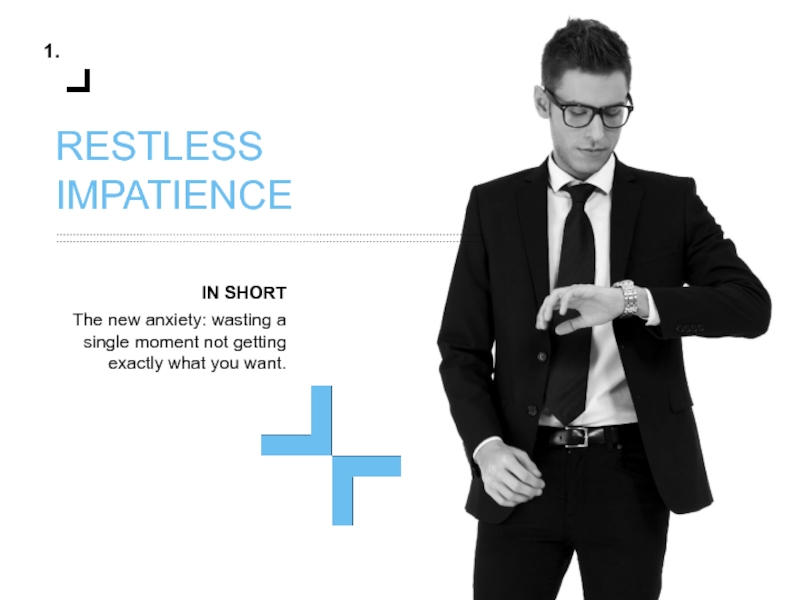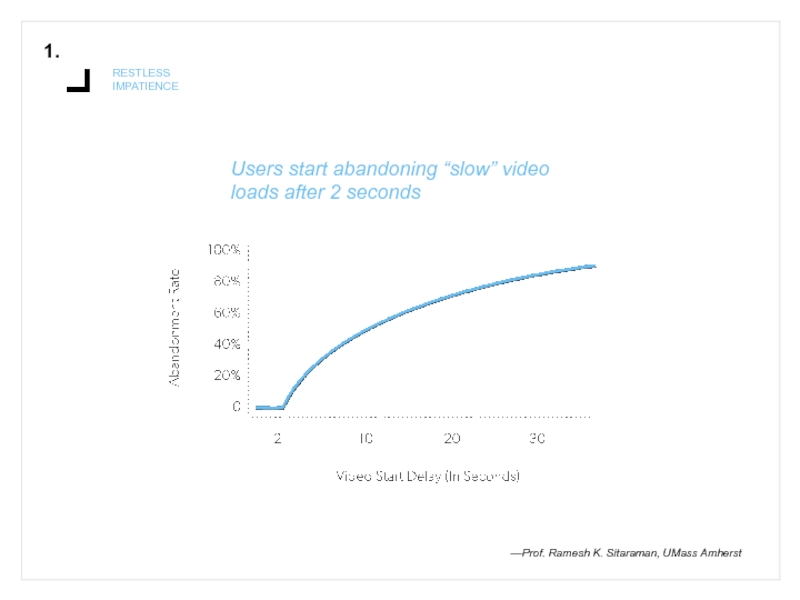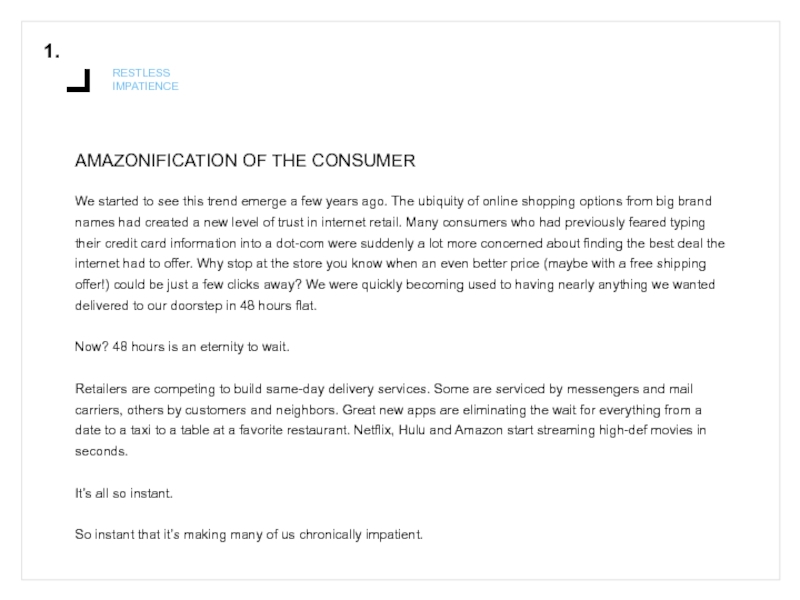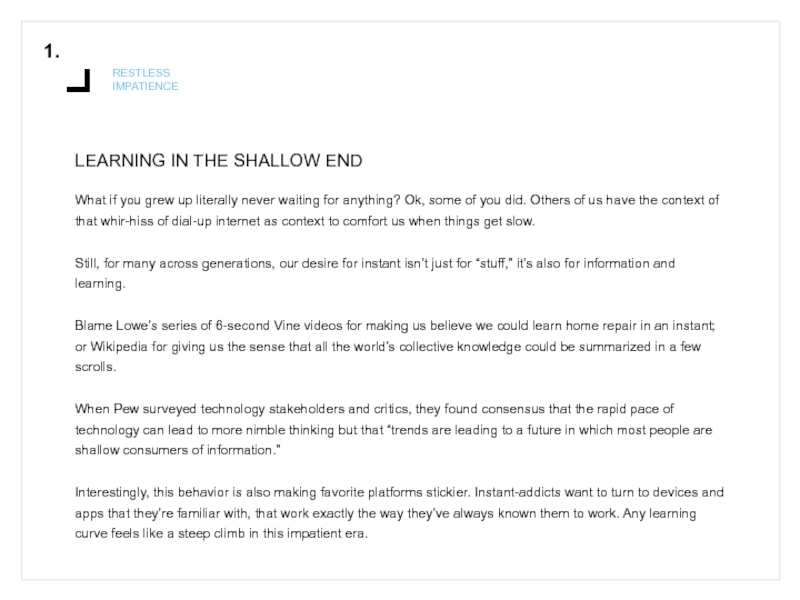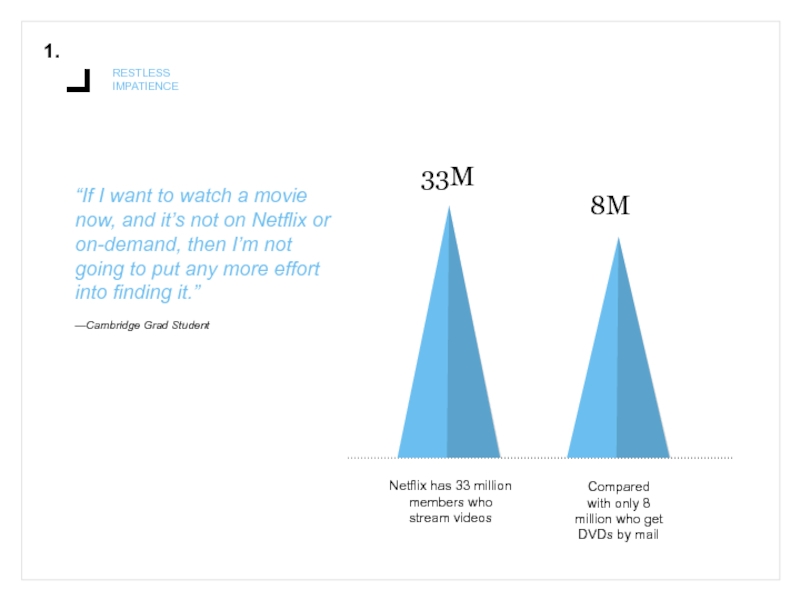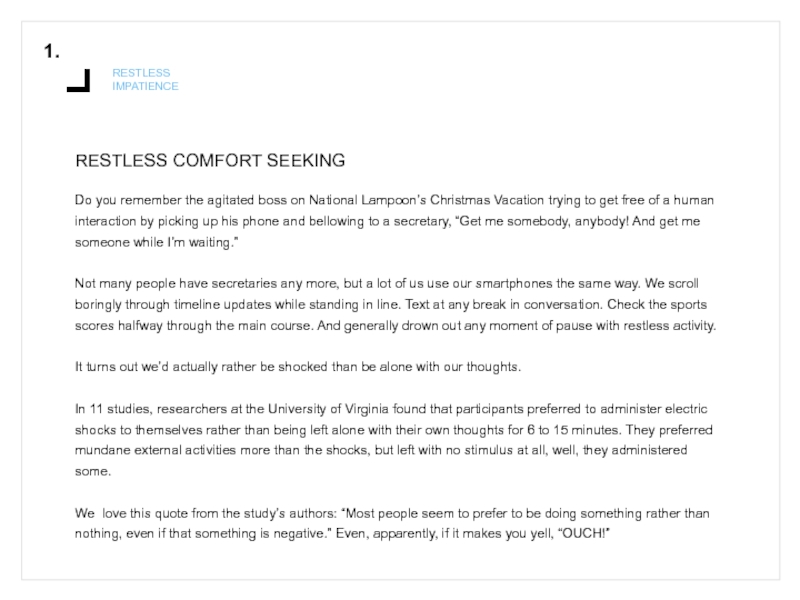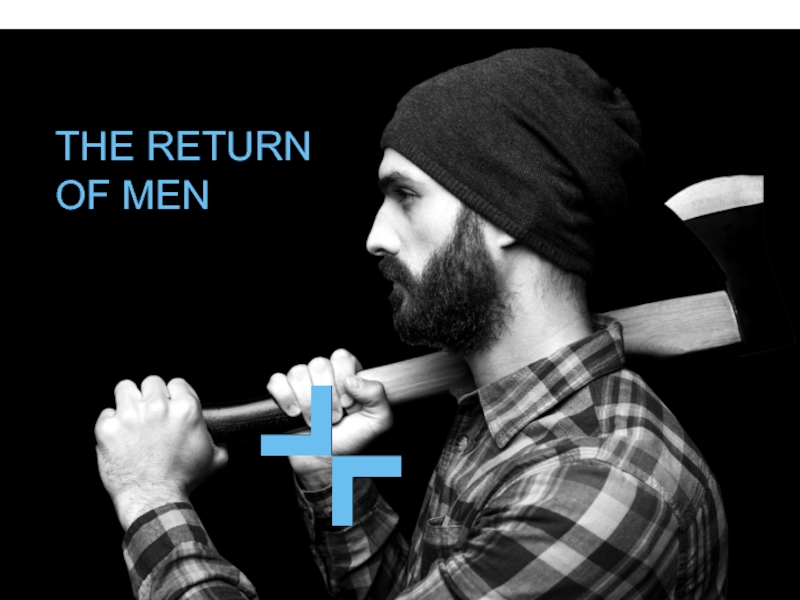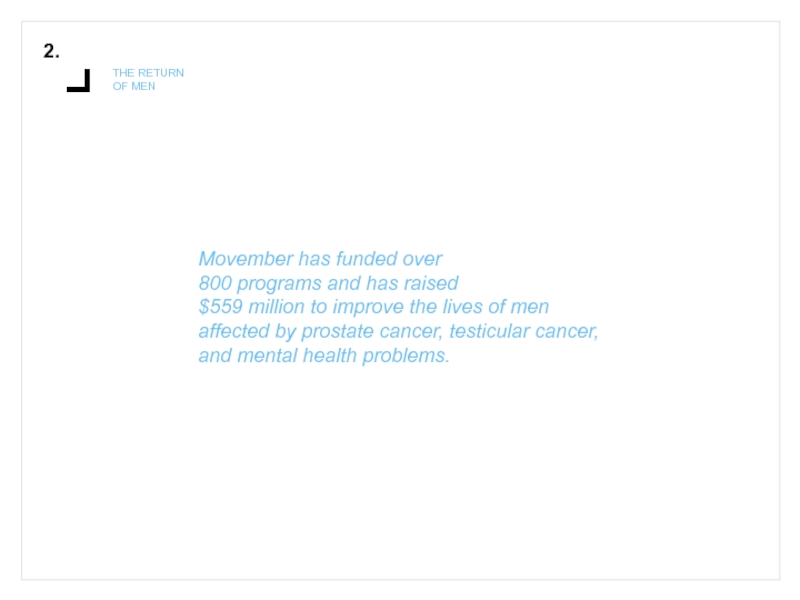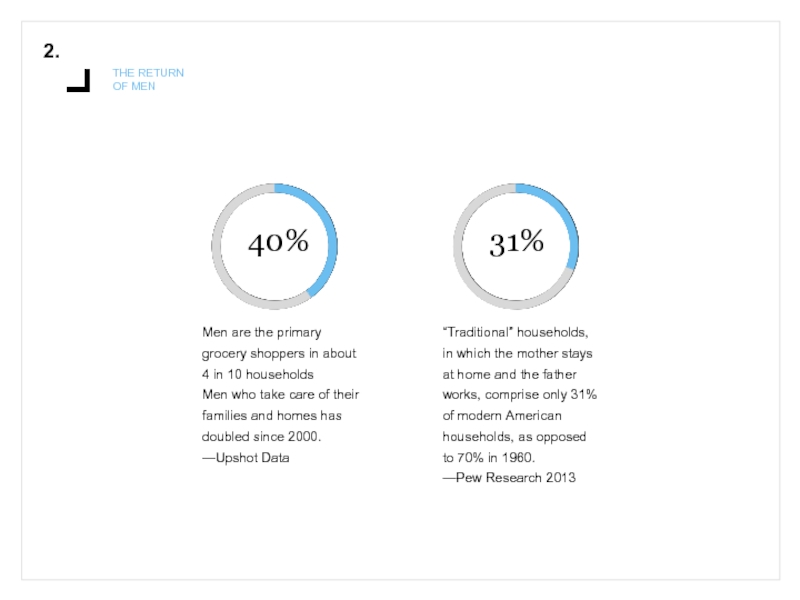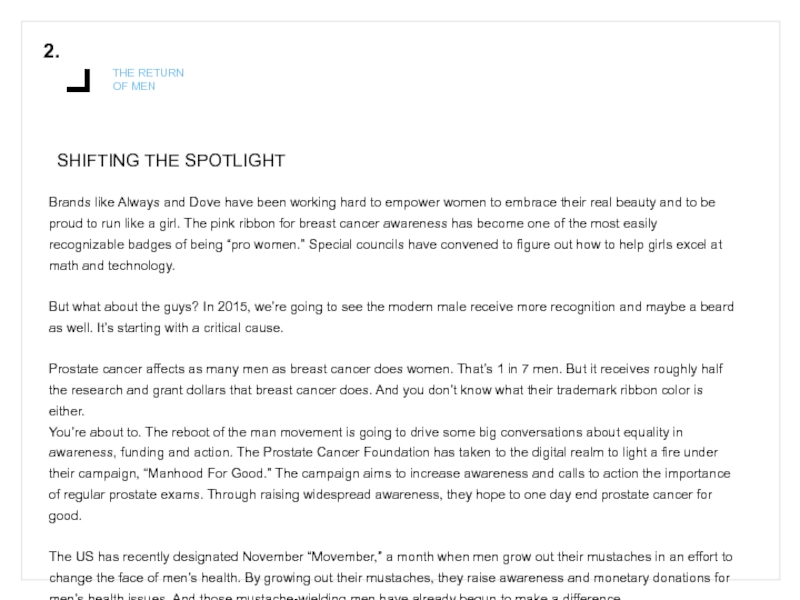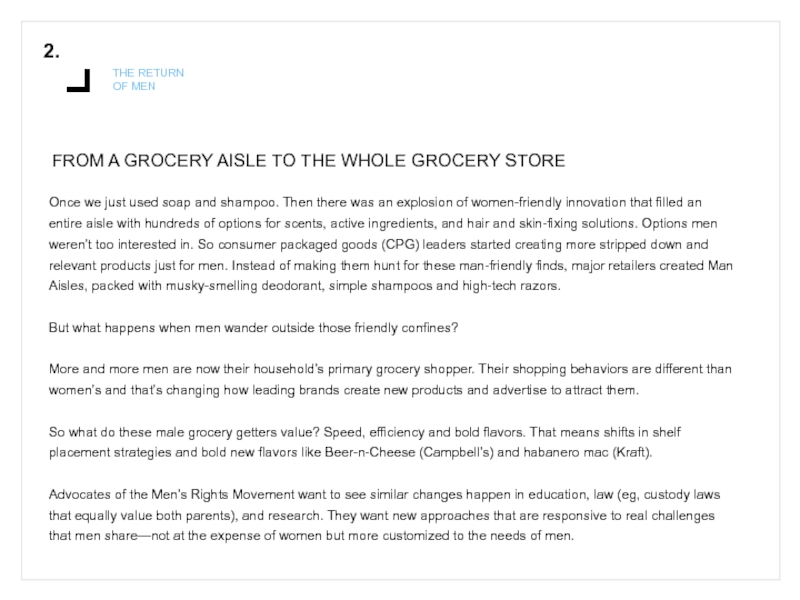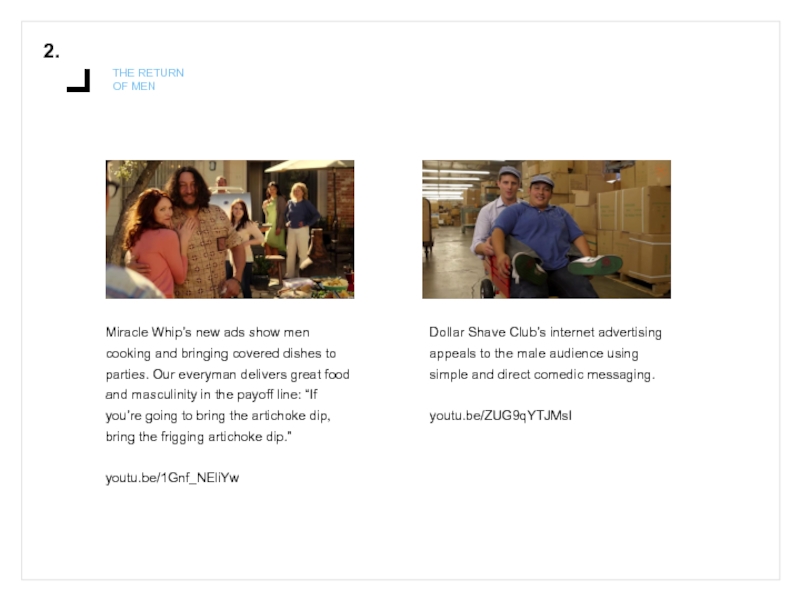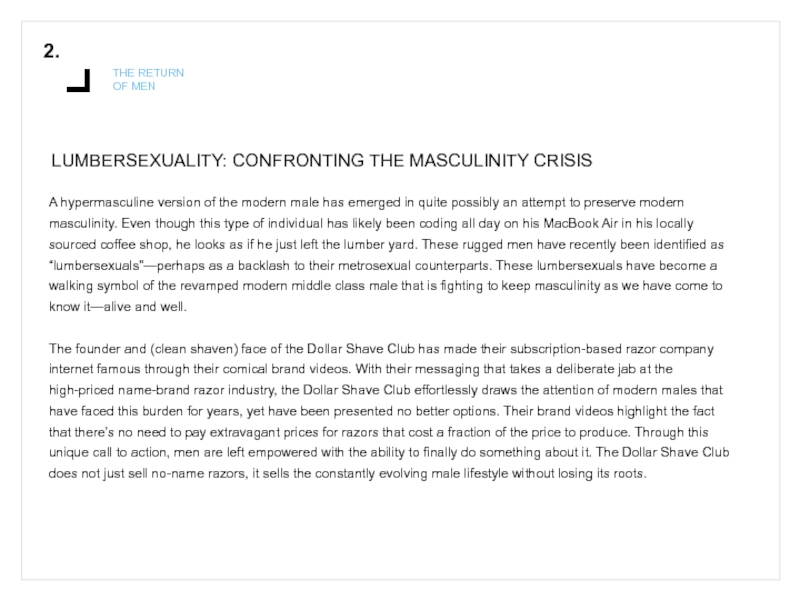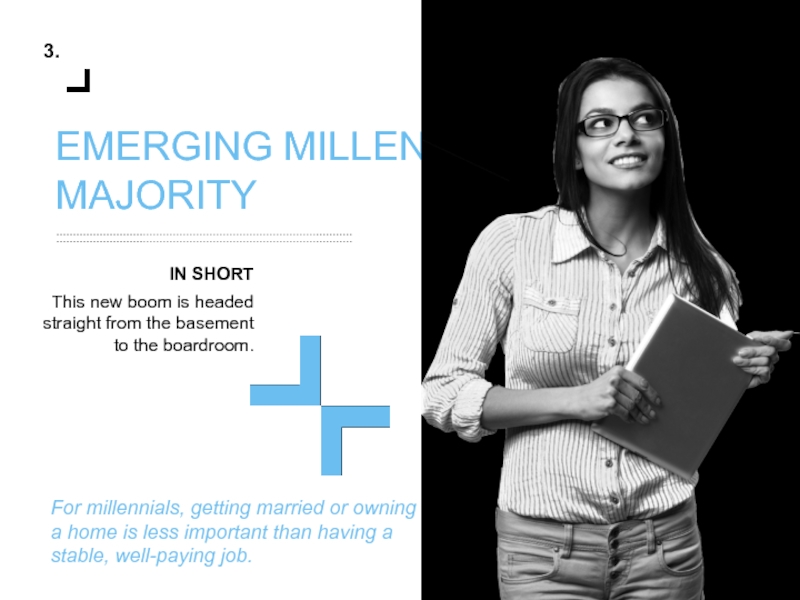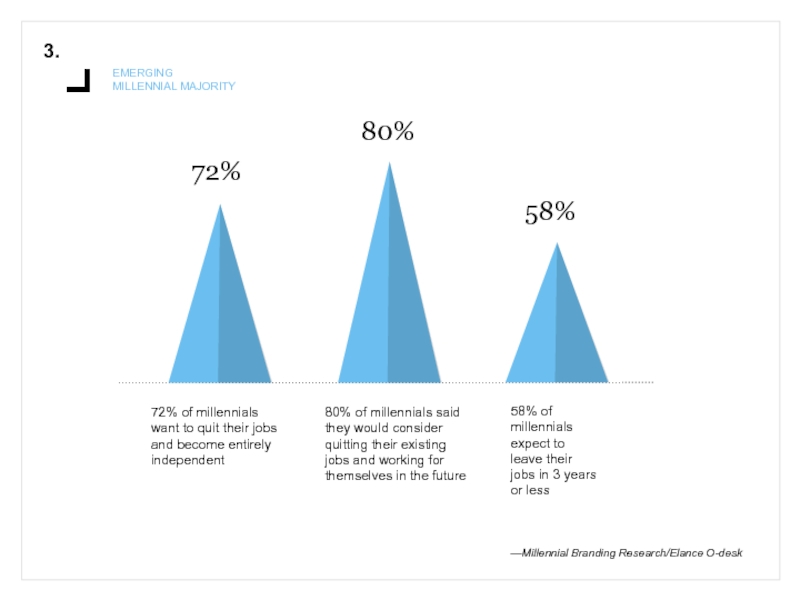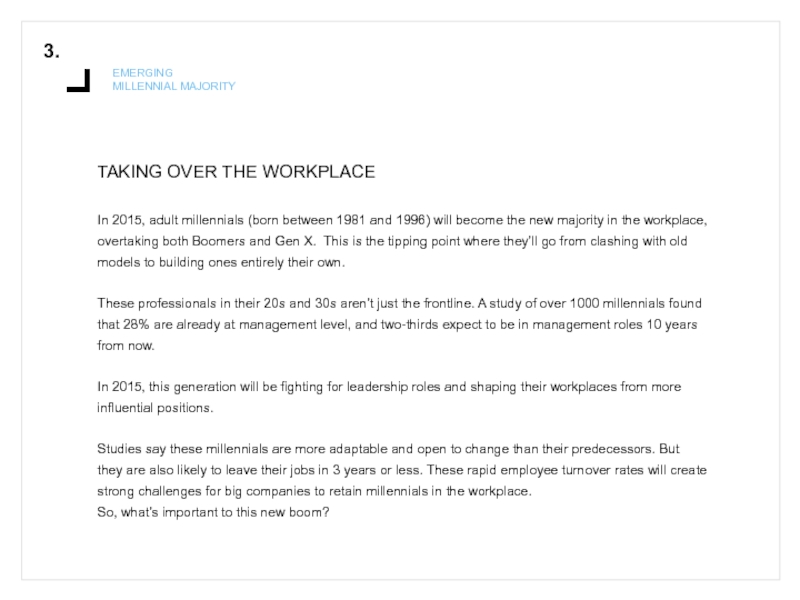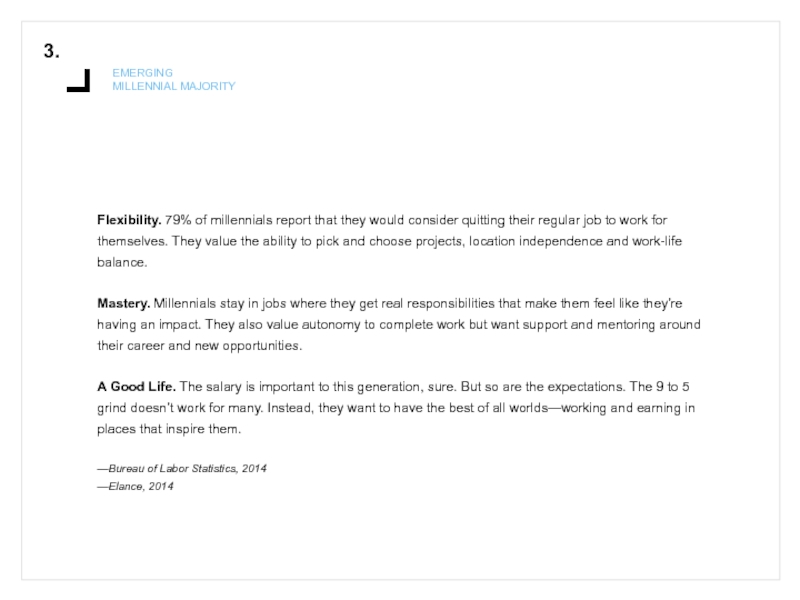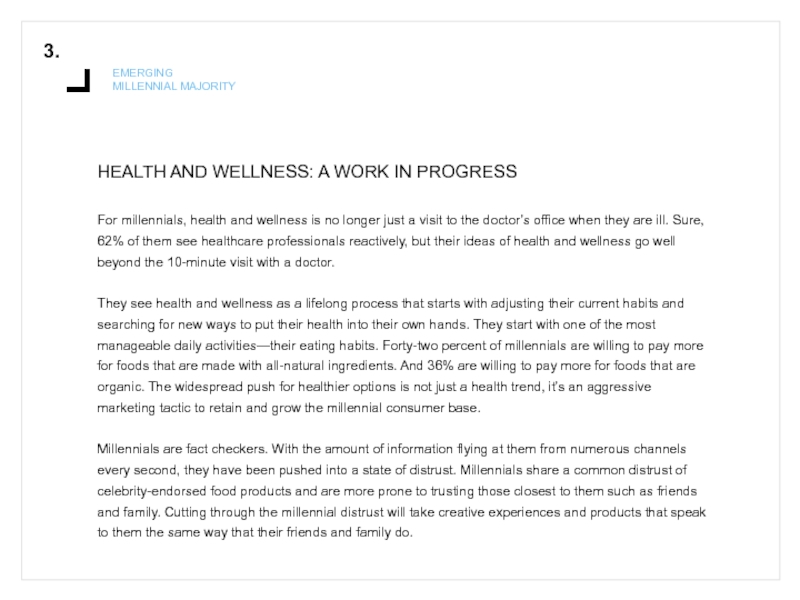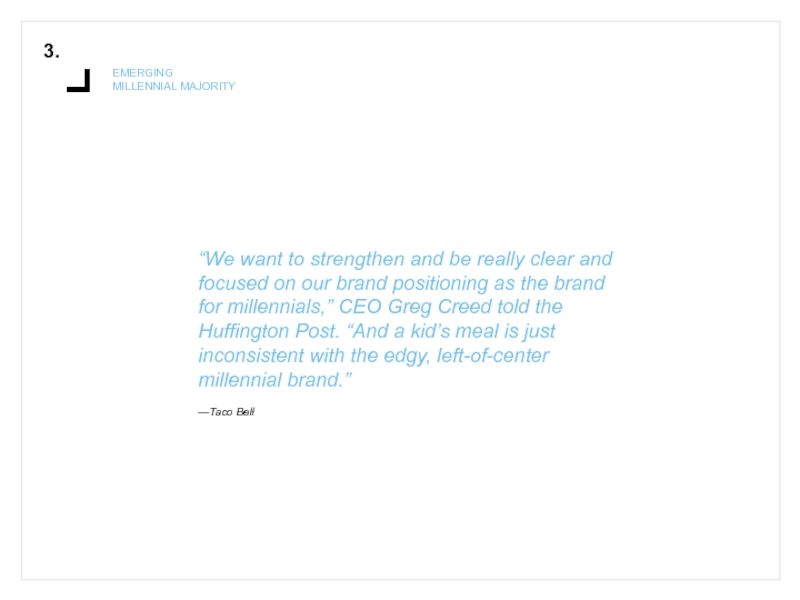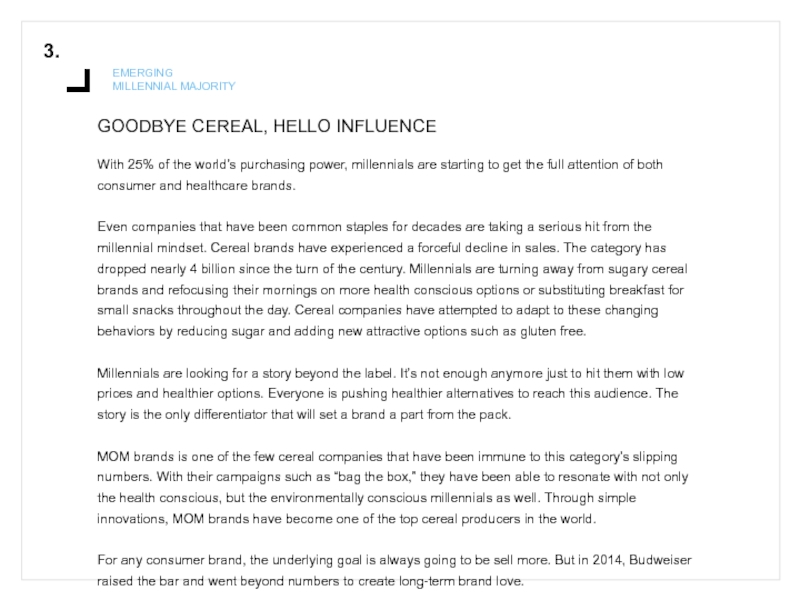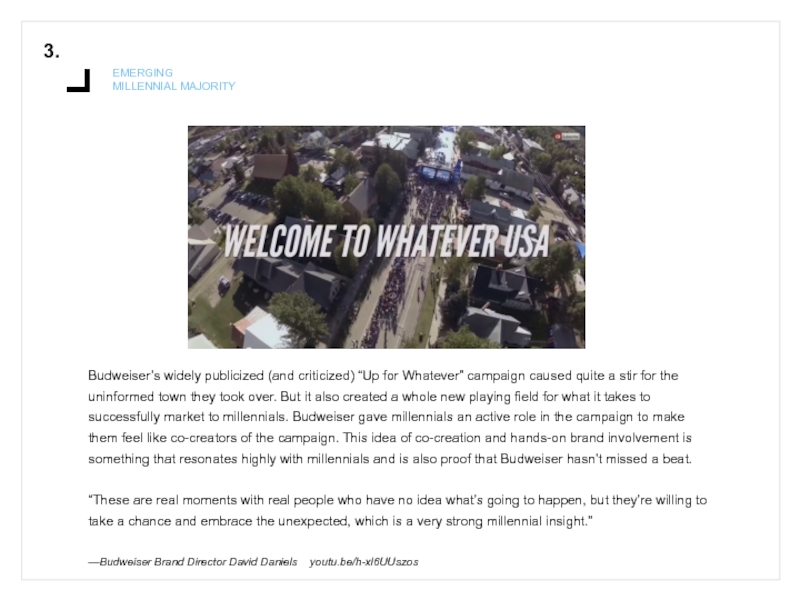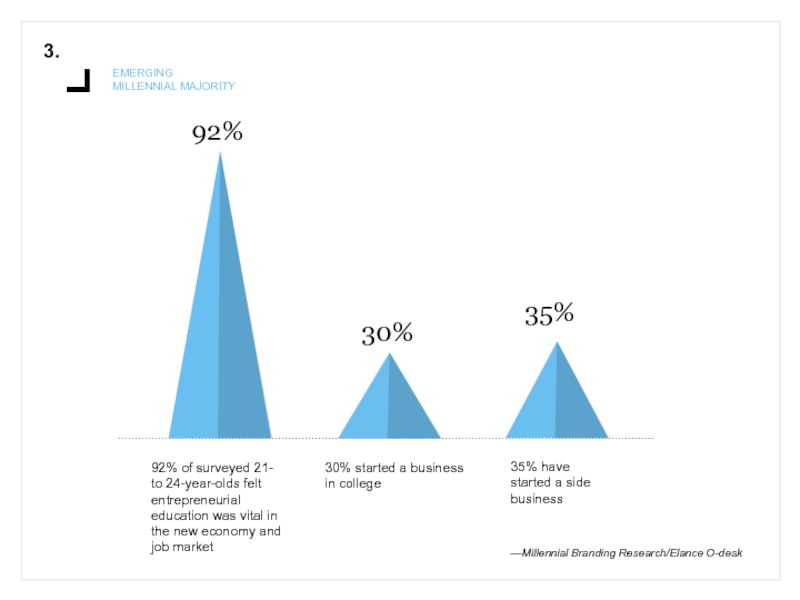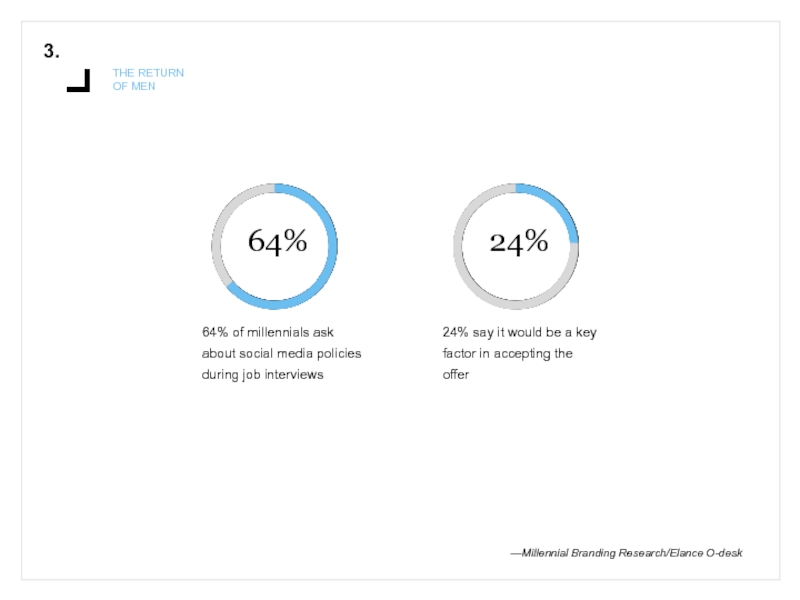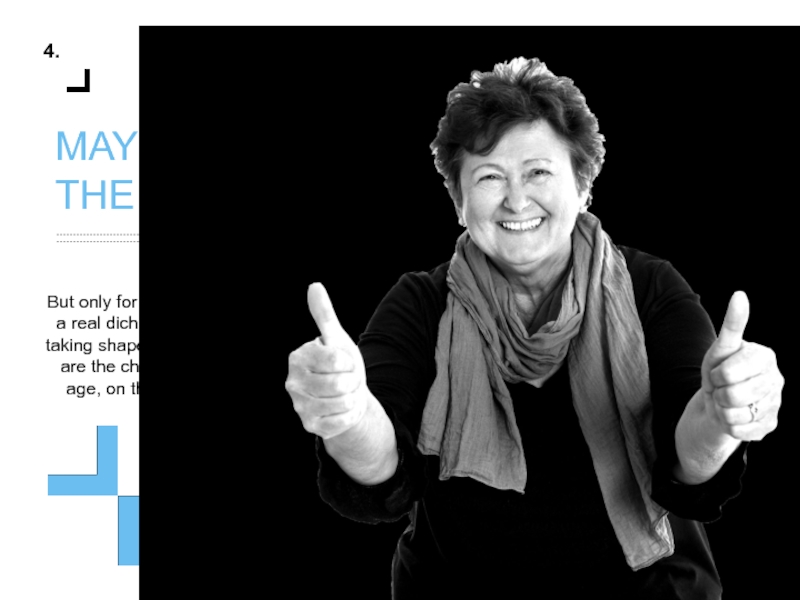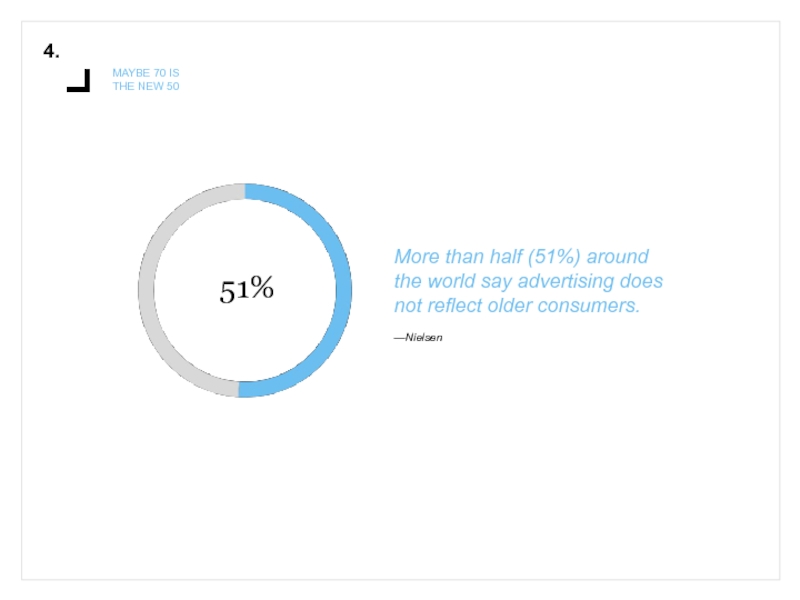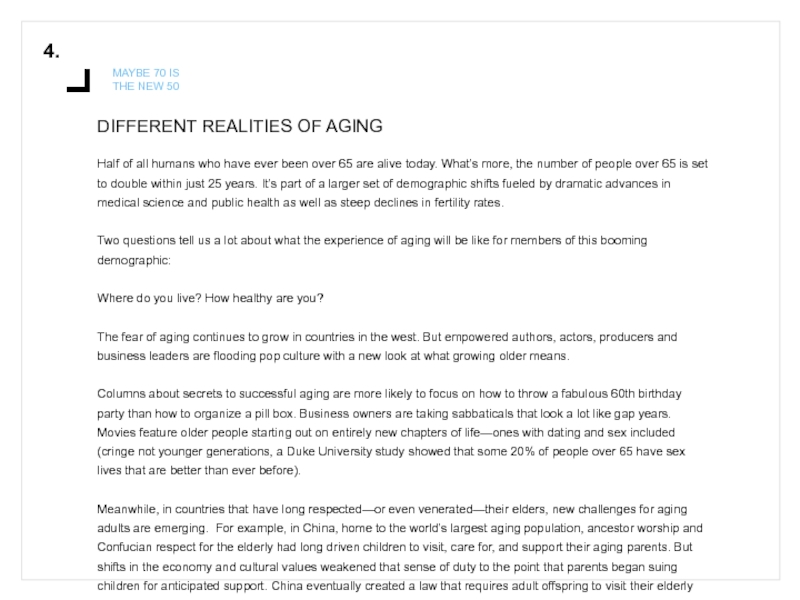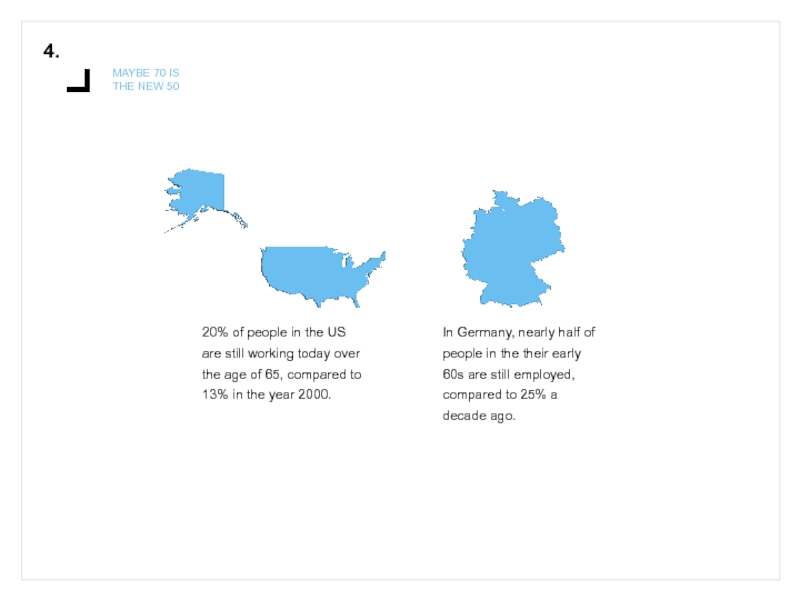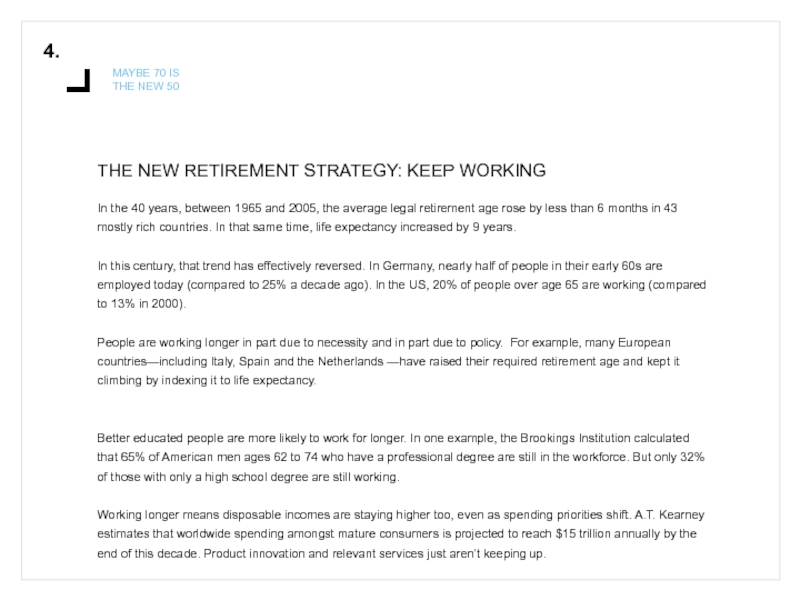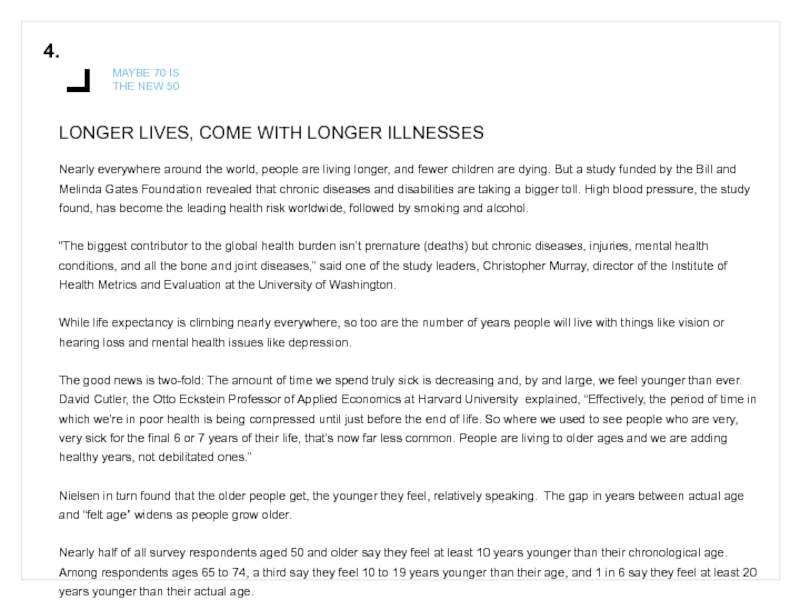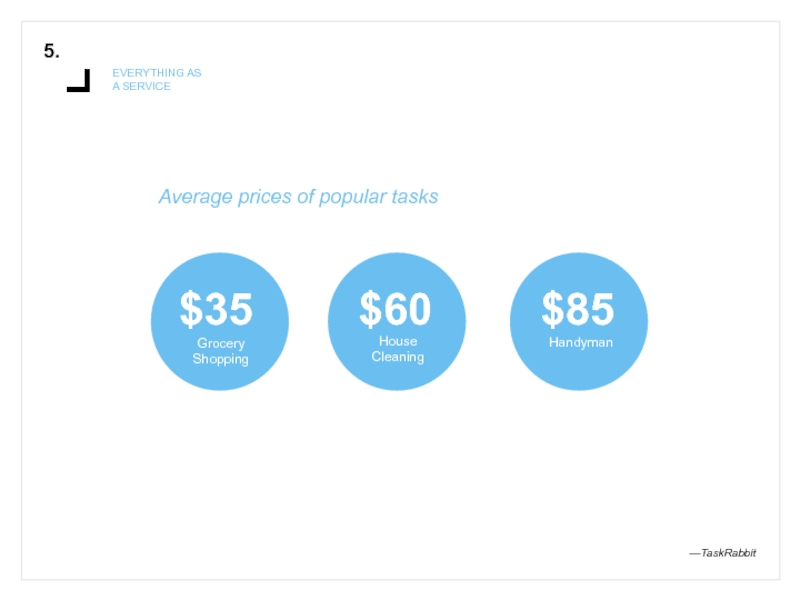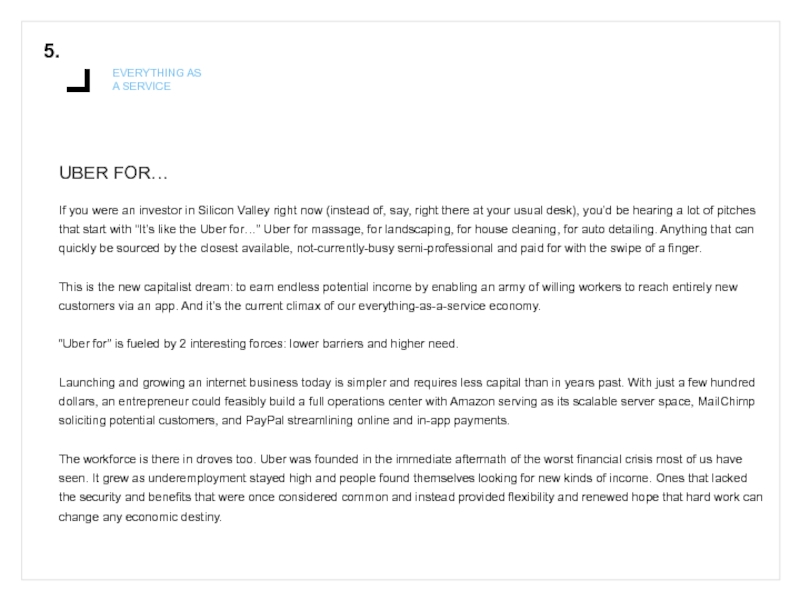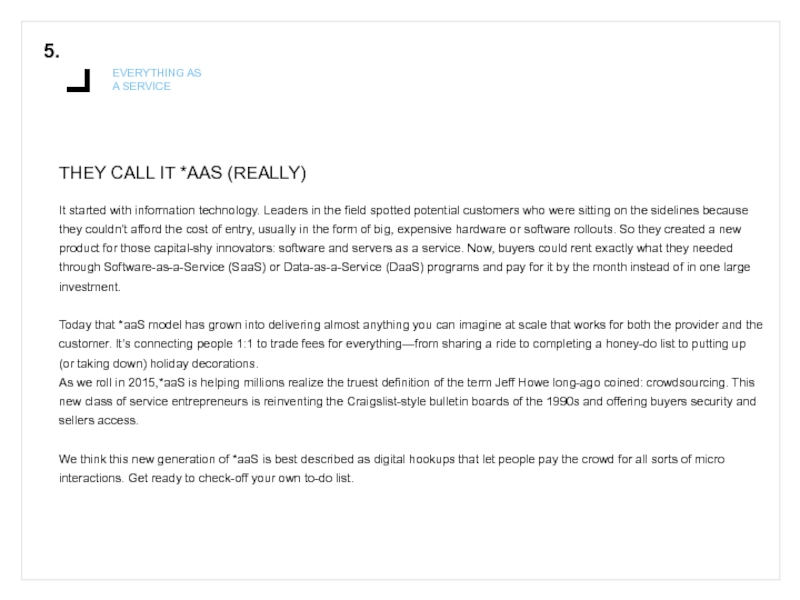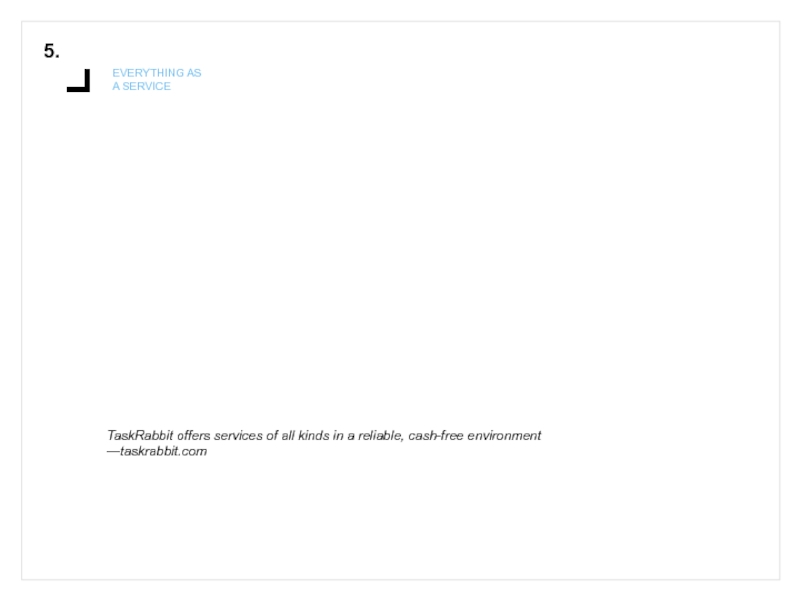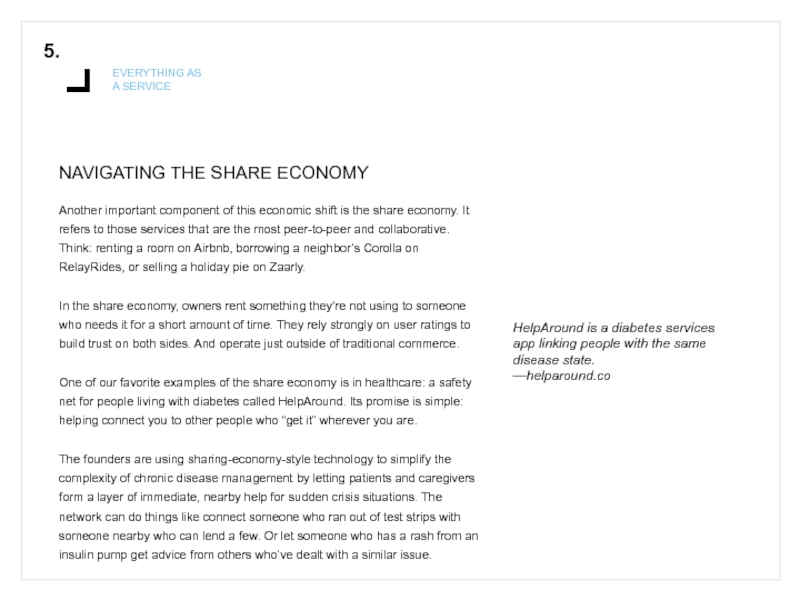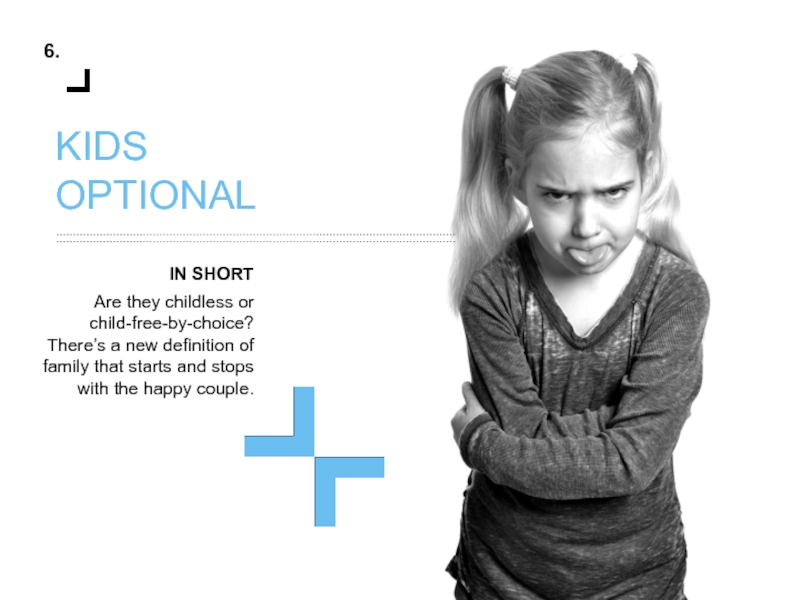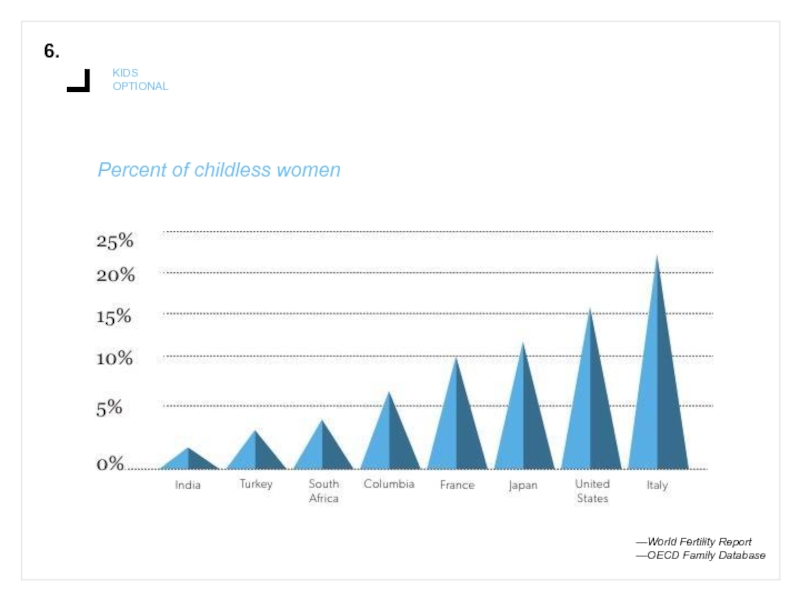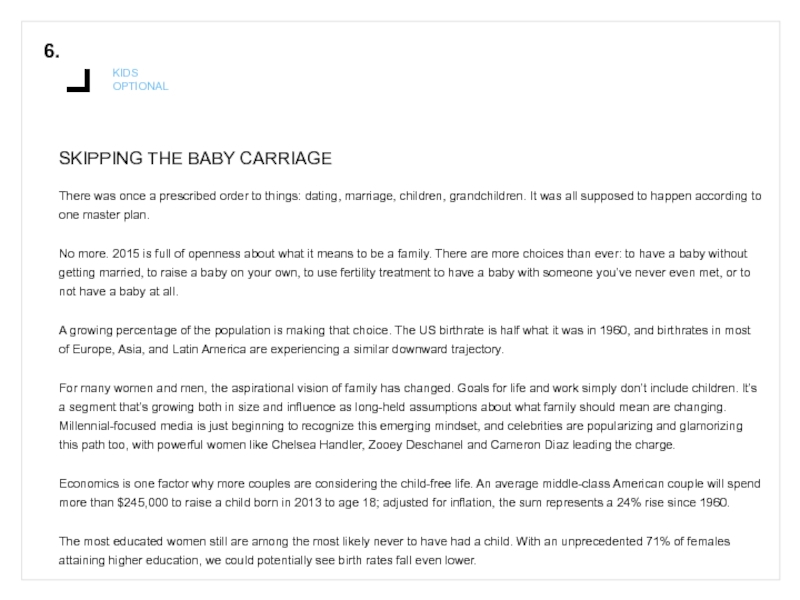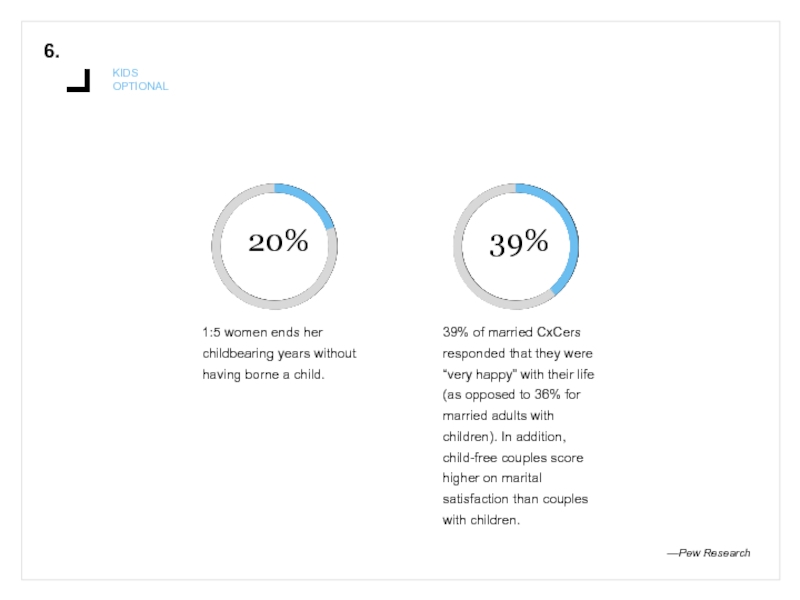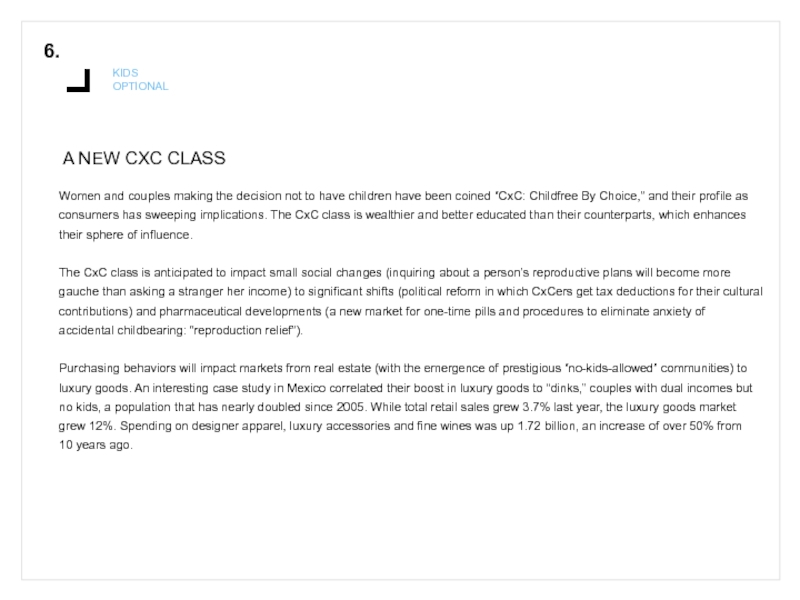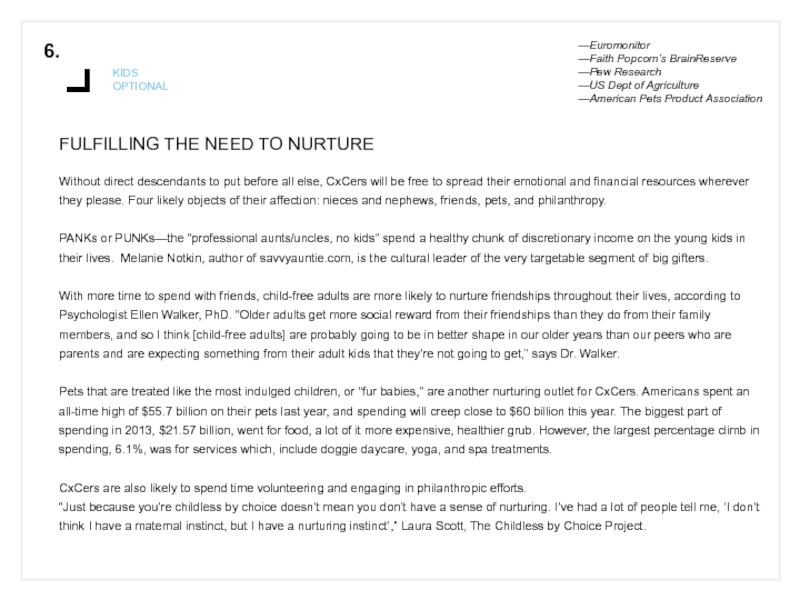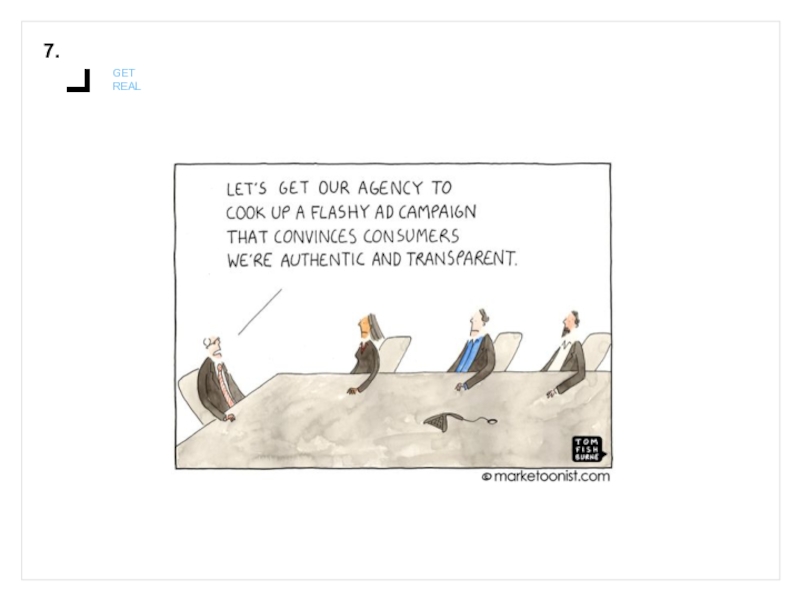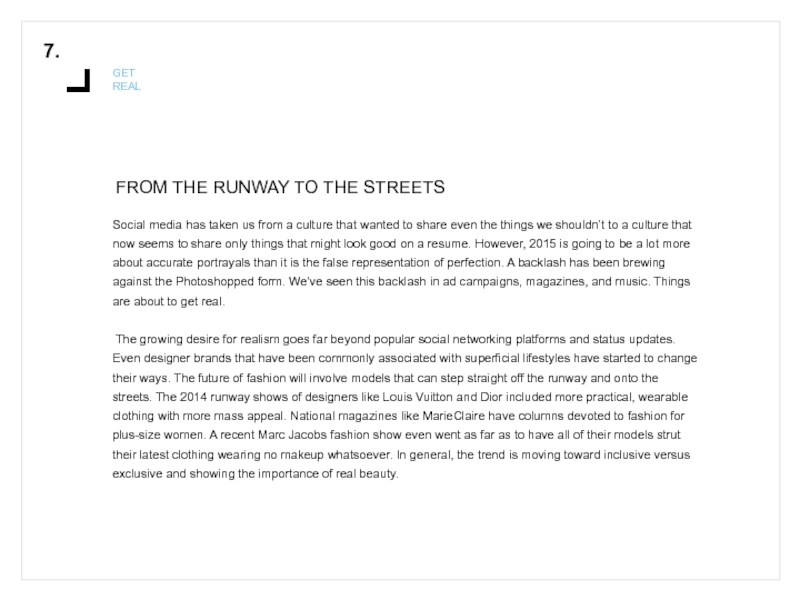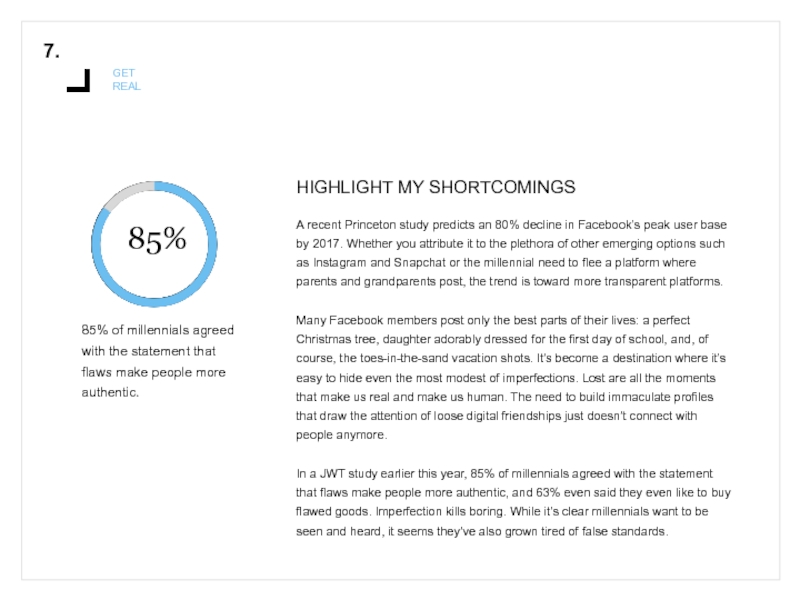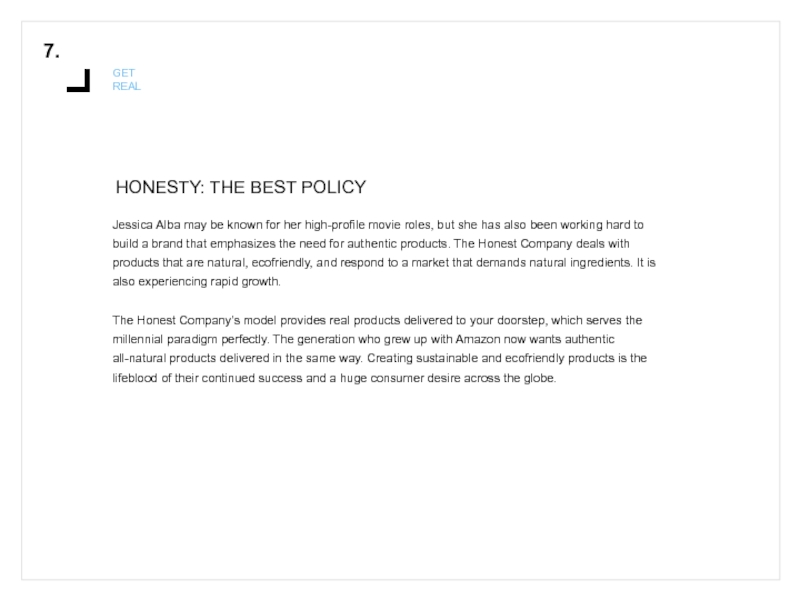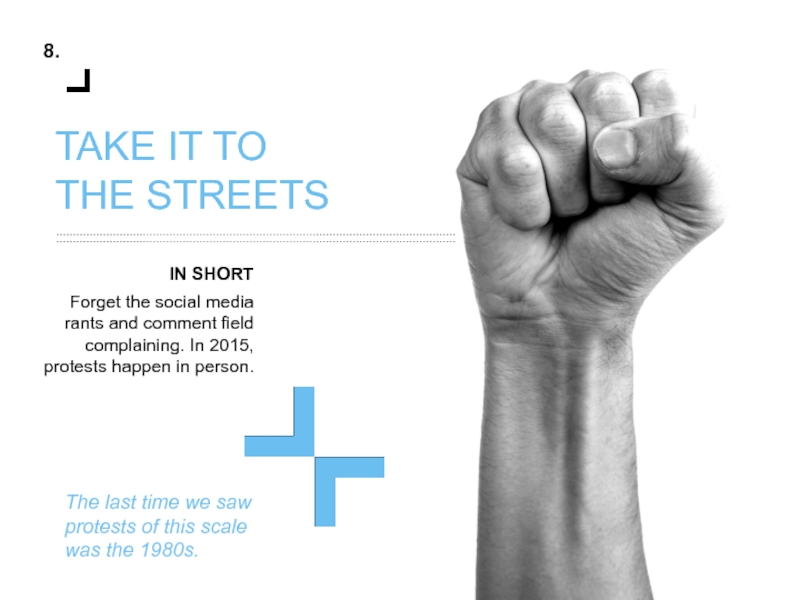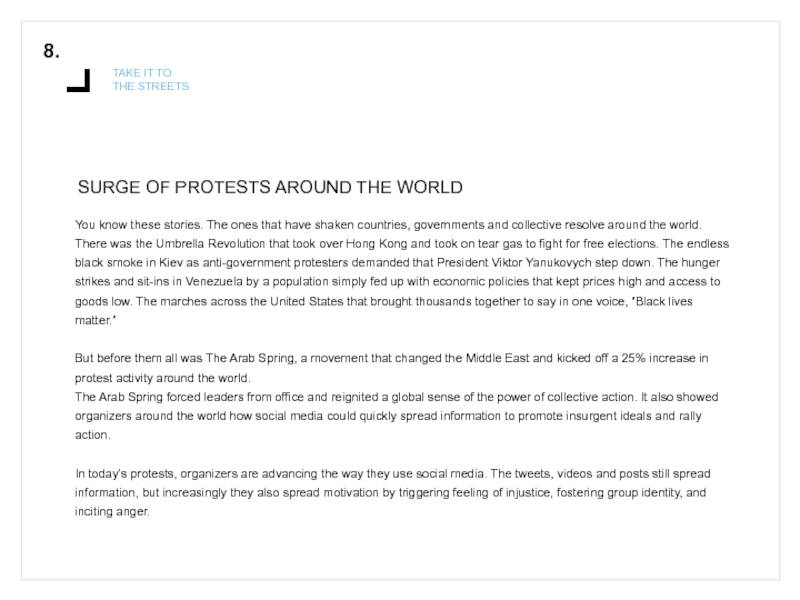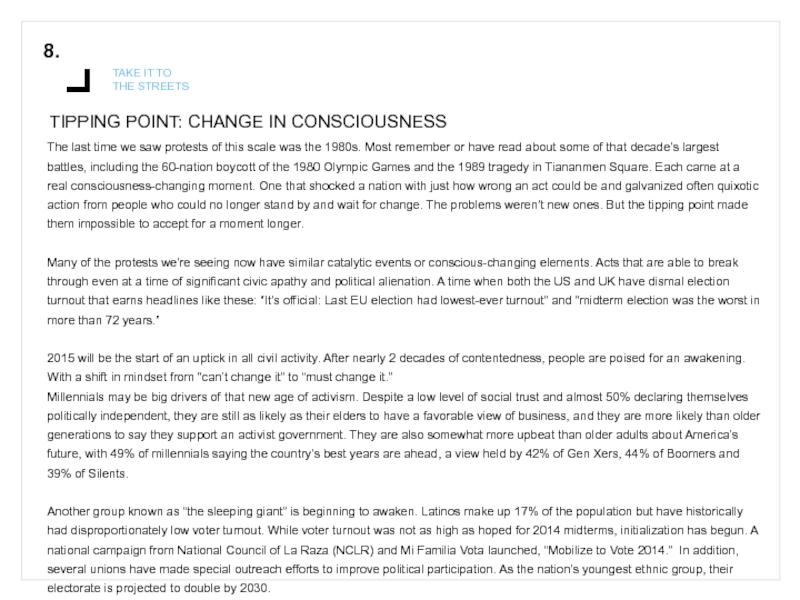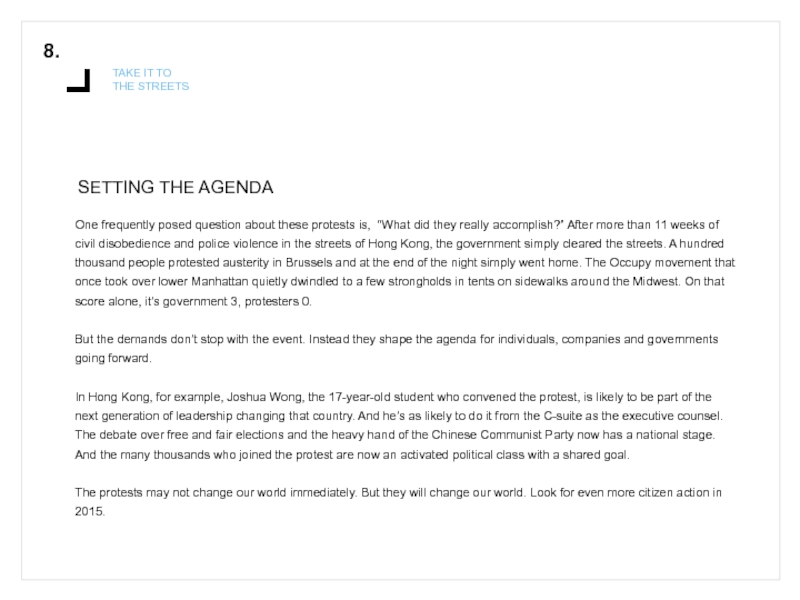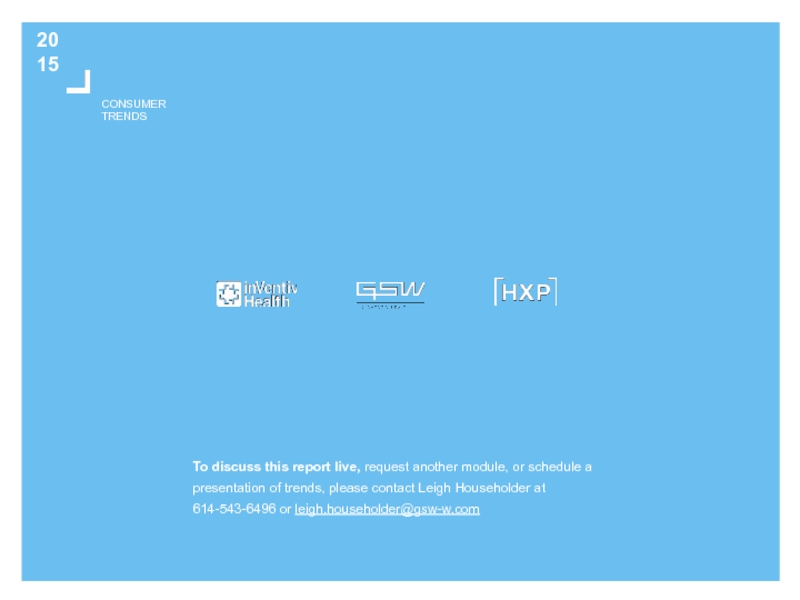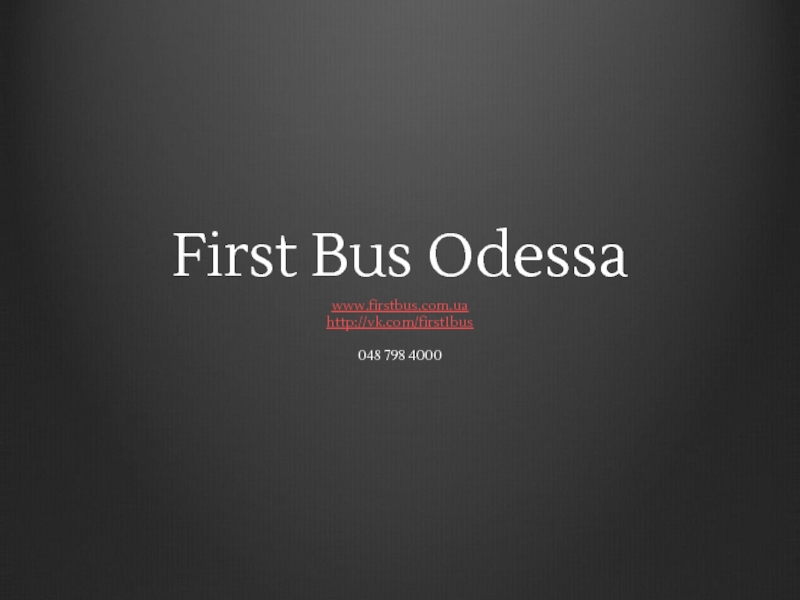- Главная
- Разное
- Дизайн
- Бизнес и предпринимательство
- Аналитика
- Образование
- Развлечения
- Красота и здоровье
- Финансы
- Государство
- Путешествия
- Спорт
- Недвижимость
- Армия
- Графика
- Культурология
- Еда и кулинария
- Лингвистика
- Английский язык
- Астрономия
- Алгебра
- Биология
- География
- Детские презентации
- Информатика
- История
- Литература
- Маркетинг
- Математика
- Медицина
- Менеджмент
- Музыка
- МХК
- Немецкий язык
- ОБЖ
- Обществознание
- Окружающий мир
- Педагогика
- Русский язык
- Технология
- Физика
- Философия
- Химия
- Шаблоны, картинки для презентаций
- Экология
- Экономика
- Юриспруденция
CON SUM ER презентация
Содержание
- 1. CON SUM ER
- 2. 20 15 CONSUMER TRENDS Our fifth annual
- 3. Abigail Schmelzer Alex Brock Andrea Evans Angela
- 4. At the core of our innovation practice
- 5. Restless Impatience The Return of Men Emerging
- 6. 1. IN SHORT The new anxiety: wasting
- 7. 1. RESTLESS IMPATIENCE Users start abandoning “slow”
- 8. 1. RESTLESS IMPATIENCE Amazonification of the consumer
- 9. 1. RESTLESS IMPATIENCE Learning in the shallow
- 10. 1. RESTLESS IMPATIENCE 33M Netflix has 33
- 11. 1. RESTLESS IMPATIENCE Restless comfort seeking
- 12. 2. IN SHORT The old majority is
- 13. 2. THE RETURN OF MEN Movember has
- 14. 2. THE RETURN OF MEN 40% 31%
- 15. 2. THE RETURN OF MEN Shifting the
- 16. 2. THE RETURN OF MEN From a
- 17. 2. THE RETURN OF MEN Miracle Whip’s
- 18. 2. THE RETURN OF MEN Lumbersexuality: Confronting
- 19. 3. IN SHORT This new boom is
- 20. 3. EMERGING MILLENNIAL MAJORITY 72% 72%
- 21. Taking over the workplace 3. EMERGING
- 22. 3. EMERGING MILLENNIAL MAJORITY Flexibility. 79%
- 23. Health and wellness: a work in progress
- 24. 3. EMERGING MILLENNIAL MAJORITY “We want
- 25. Goodbye cereal, hello influence 3. EMERGING
- 26. 3. EMERGING MILLENNIAL MAJORITY Budweiser’s widely
- 27. 3. EMERGING MILLENNIAL MAJORITY 92% 92%
- 28. 3. THE RETURN OF MEN 64% 24%
- 29. 4. IN SHORT But only for some.
- 30. 4. MAYBE 70 IS THE NEW
- 31. Different realities of aging 4. MAYBE 70
- 32. 4. MAYBE 70 IS THE NEW
- 33. The new retirement strategy: Keep working 4.
- 34. Longer lives, come with longer illnesses 4.
- 35. 5. IN SHORT Why act when you
- 36. 5. EVERYTHING AS A SERVICE Average prices
- 37. Uber for… 5. EVERYTHING AS A SERVICE
- 38. They call it *aaS (really) 5. EVERYTHING
- 39. 5. EVERYTHING AS A SERVICE TaskRabbit offers
- 40. Navigating the share economy 5. EVERYTHING AS
- 41. 6. IN SHORT Are they childless or
- 42. 6. KIDS OPTIONAL Percent of childless women —World Fertility Report —OECD Family Database
- 43. Skipping the baby carriage 6. KIDS OPTIONAL
- 44. 6. KIDS OPTIONAL 20% 39% 1:5 women
- 45. A new CxC class 6. KIDS
- 46. fulfilling the need to nurture 6. KIDS
- 47. 7. IN SHORT Tired of trying to
- 48. 7. GET REAL
- 49. From the Runway to the Streets 7.
- 50. Highlight My Shortcomings 7. GET REAL A
- 51. Honesty: The best policy 7. GET REAL
- 52. 7. GET REAL
- 53. 8. IN SHORT Forget the social media
- 54. Surge of protests around the world 8.
- 55. 8. TAKE IT TO THE STREETS
- 56. Tipping point: Change in consciousness 8. TAKE
- 57. Setting the agenda 8. TAKE IT TO
- 58. 20 15 CONSUMER TRENDS To discuss this
Слайд 220
15
CONSUMER
TRENDS
Our fifth annual series of trends reports includes insights into the
Слайд 3Abigail Schmelzer
Alex Brock
Andrea Evans
Angela Cua
Azul Ceballos
Bruce Rooke
Campbell Hooper
Charles DiSantis
Chelsea Bailey
Duncan Arbour
Eduardo
Eric Davis
Fred Harrison
James Tomasino
Jeffrey Giermek
Jeffrey Wilks
Jessie Brown
Joe DeSalvo
John Mucha
Joy Hart
Julie Valka
Kathryn Bernish-Fisher
Kevin Nalty
Leigh Householder
Luke Hebblethwaite
Matt Groom
Mike Martins
Nick Bartlett
Nicole Sordell
Pavithra Selvam
Phil Storer
Richard Martin
Rick Summa
Sam Cannizzaro
Sarah Brown
Sayeed Anwar
Scott Raidel
Stefanie Jones
Zach Gerber
CORE
CONTRIBUTORS
20
15
CONSUMER
TRENDS
Слайд 4At the core of our innovation practice is a simple idea:
Knowing how people’s expectations are changing lets us capture new market opportunities, take smart risks, and spur innovation.
We start by uncovering clues. Clues are data points, great stories, quotes, and pictures that shift our understanding of what people want right now. We find them in practices around the world and in the technologies, brands, and experiences that doctors and patients encounter in their everyday lives.
Over time, those clues combine and connect to reveal trends, a new kind of inspiration for creating experiences in the moments before our customers realize they need them. And months and years before our competitors realize the same thing.
20
15
CONSUMER
TRENDS
Слайд 5 Restless Impatience
The Return of Men
Emerging Millennial Majority
Maybe 70 is the New
Everything As A Service
Kids Optional
Get Real
Take It To The Streets
We’re following eight trends that show how
the consumer landscape will be changing in 2015.
THE
TRENDS
1.
2.
3.
4.
5.
6.
7.
8.
Слайд 61.
IN SHORT
The new anxiety: wasting a single moment not getting exactly
RESTLESS
IMPATIENCE
Слайд 71.
RESTLESS
IMPATIENCE
Users start abandoning “slow” video loads after 2 seconds
—Prof. Ramesh K.
Слайд 81.
RESTLESS
IMPATIENCE
Amazonification of the consumer
We started to see this trend emerge a
Now? 48 hours is an eternity to wait.
Retailers are competing to build same-day delivery services. Some are serviced by messengers and mail carriers, others by customers and neighbors. Great new apps are eliminating the wait for everything from a date to a taxi to a table at a favorite restaurant. Netflix, Hulu and Amazon start streaming high-def movies in seconds.
It’s all so instant.
So instant that it’s making many of us chronically impatient.
Слайд 91.
RESTLESS
IMPATIENCE
Learning in the shallow end
What if you grew up literally never
Still, for many across generations, our desire for instant isn’t just for “stuff,” it’s also for information and learning.
Blame Lowe’s series of 6-second Vine videos for making us believe we could learn home repair in an instant; or Wikipedia for giving us the sense that all the world’s collective knowledge could be summarized in a few scrolls.
When Pew surveyed technology stakeholders and critics, they found consensus that the rapid pace of technology can lead to more nimble thinking but that “trends are leading to a future in which most people are shallow consumers of information.”
Interestingly, this behavior is also making favorite platforms stickier. Instant-addicts want to turn to devices and apps that they’re familiar with, that work exactly the way they’ve always known them to work. Any learning curve feels like a steep climb in this impatient era.
Слайд 101.
RESTLESS
IMPATIENCE
33M
Netflix has 33 million members who
stream videos
8M
Compared with only 8
“If I want to watch a movie now, and it’s not on Netflix or on-demand, then I’m not going to put any more effort into finding it.”
—Cambridge Grad Student
Слайд 111.
RESTLESS
IMPATIENCE
Restless comfort seeking
Do you remember the agitated boss on National Lampoon’s
Not many people have secretaries any more, but a lot of us use our smartphones the same way. We scroll boringly through timeline updates while standing in line. Text at any break in conversation. Check the sports scores halfway through the main course. And generally drown out any moment of pause with restless activity.
It turns out we’d actually rather be shocked than be alone with our thoughts.
In 11 studies, researchers at the University of Virginia found that participants preferred to administer electric shocks to themselves rather than being left alone with their own thoughts for 6 to 15 minutes. They preferred mundane external activities more than the shocks, but left with no stimulus at all, well, they administered some.
We love this quote from the study’s authors: “Most people seem to prefer to be doing something rather than nothing, even if that something is negative.” Even, apparently, if it makes you yell, “OUCH!”
Слайд 132.
THE RETURN
OF MEN
Movember has funded over
800 programs and has raised
$559 million to improve the lives of men affected by prostate cancer, testicular cancer, and mental health problems.
Слайд 142.
THE RETURN
OF MEN
40%
31%
Men are the primary grocery shoppers in about 4
Men who take care of their families and homes has doubled since 2000.
—Upshot Data
“Traditional” households, in which the mother stays at home and the father works, comprise only 31% of modern American households, as opposed to 70% in 1960.
—Pew Research 2013
Слайд 152.
THE RETURN
OF MEN
Shifting the Spotlight
Brands like Always and Dove have been
But what about the guys? In 2015, we’re going to see the modern male receive more recognition and maybe a beard as well. It’s starting with a critical cause.
Prostate cancer affects as many men as breast cancer does women. That’s 1 in 7 men. But it receives roughly half the research and grant dollars that breast cancer does. And you don’t know what their trademark ribbon color is either.
You’re about to. The reboot of the man movement is going to drive some big conversations about equality in awareness, funding and action. The Prostate Cancer Foundation has taken to the digital realm to light a fire under their campaign, “Manhood For Good.” The campaign aims to increase awareness and calls to action the importance of regular prostate exams. Through raising widespread awareness, they hope to one day end prostate cancer for good.
The US has recently designated November “Movember,” a month when men grow out their mustaches in an effort to change the face of men’s health. By growing out their mustaches, they raise awareness and monetary donations for men’s health issues. And those mustache-wielding men have already begun to make a difference.
Слайд 162.
THE RETURN
OF MEN
From a Grocery Aisle to the Whole Grocery StorE
Once
But what happens when men wander outside those friendly confines?
More and more men are now their household’s primary grocery shopper. Their shopping behaviors are different than women’s and that’s changing how leading brands create new products and advertise to attract them.
So what do these male grocery getters value? Speed, efficiency and bold flavors. That means shifts in shelf placement strategies and bold new flavors like Beer-n-Cheese (Campbell’s) and habanero mac (Kraft).
Advocates of the Men’s Rights Movement want to see similar changes happen in education, law (eg, custody laws that equally value both parents), and research. They want new approaches that are responsive to real challenges that men share—not at the expense of women but more customized to the needs of men.
Слайд 172.
THE RETURN
OF MEN
Miracle Whip’s new ads show men cooking and bringing
youtu.be/1Gnf_NEliYw
Dollar Shave Club’s internet advertising appeals to the male audience using simple and direct comedic messaging.
youtu.be/ZUG9qYTJMsI
Слайд 182.
THE RETURN
OF MEN
Lumbersexuality: Confronting the Masculinity Crisis
A hypermasculine version of the
The founder and (clean shaven) face of the Dollar Shave Club has made their subscription-based razor company internet famous through their comical brand videos. With their messaging that takes a deliberate jab at the high-priced name-brand razor industry, the Dollar Shave Club effortlessly draws the attention of modern males that have faced this burden for years, yet have been presented no better options. Their brand videos highlight the fact that there’s no need to pay extravagant prices for razors that cost a fraction of the price to produce. Through this unique call to action, men are left empowered with the ability to finally do something about it. The Dollar Shave Club does not just sell no-name razors, it sells the constantly evolving male lifestyle without losing its roots.
Слайд 193.
IN SHORT
This new boom is headed straight from the basement to
EMERGING MILLENNIAL MAJORITY
For millennials, getting married or owning a home is less important than having a stable, well-paying job.
Слайд 203.
EMERGING
MILLENNIAL MAJORITY
72%
72% of millennials want to quit their jobs and
80%
80% of millennials said they would consider quitting their existing jobs and working for themselves in the future
58% of millennials expect to leave their jobs in 3 years or less
58%
—Millennial Branding Research/Elance O-desk
Слайд 21Taking over the workplace
3.
EMERGING
MILLENNIAL MAJORITY
In 2015, adult millennials (born between
These professionals in their 20s and 30s aren’t just the frontline. A study of over 1000 millennials found that 28% are already at management level, and two-thirds expect to be in management roles 10 years from now.
In 2015, this generation will be fighting for leadership roles and shaping their workplaces from more influential positions.
Studies say these millennials are more adaptable and open to change than their predecessors. But they are also likely to leave their jobs in 3 years or less. These rapid employee turnover rates will create strong challenges for big companies to retain millennials in the workplace.
So, what’s important to this new boom?
Слайд 223.
EMERGING
MILLENNIAL MAJORITY
Flexibility. 79% of millennials report that they would consider
Mastery. Millennials stay in jobs where they get real responsibilities that make them feel like they’re having an impact. They also value autonomy to complete work but want support and mentoring around their career and new opportunities.
A Good Life. The salary is important to this generation, sure. But so are the expectations. The 9 to 5 grind doesn’t work for many. Instead, they want to have the best of all worlds—working and earning in places that inspire them.
—Bureau of Labor Statistics, 2014
—Elance, 2014
Слайд 23Health and wellness: a work in progress
3.
EMERGING
MILLENNIAL MAJORITY
For millennials, health
They see health and wellness as a lifelong process that starts with adjusting their current habits and searching for new ways to put their health into their own hands. They start with one of the most manageable daily activities—their eating habits. Forty-two percent of millennials are willing to pay more for foods that are made with all-natural ingredients. And 36% are willing to pay more for foods that are organic. The widespread push for healthier options is not just a health trend, it’s an aggressive marketing tactic to retain and grow the millennial consumer base.
Millennials are fact checkers. With the amount of information flying at them from numerous channels every second, they have been pushed into a state of distrust. Millennials share a common distrust of celebrity-endorsed food products and are more prone to trusting those closest to them such as friends and family. Cutting through the millennial distrust will take creative experiences and products that speak to them the same way that their friends and family do.
Слайд 243.
EMERGING
MILLENNIAL MAJORITY
“We want to strengthen and be really clear and
—Taco Bell
Слайд 25Goodbye cereal, hello influence
3.
EMERGING
MILLENNIAL MAJORITY
With 25% of the world’s purchasing
Even companies that have been common staples for decades are taking a serious hit from the millennial mindset. Cereal brands have experienced a forceful decline in sales. The category has dropped nearly 4 billion since the turn of the century. Millennials are turning away from sugary cereal brands and refocusing their mornings on more health conscious options or substituting breakfast for small snacks throughout the day. Cereal companies have attempted to adapt to these changing behaviors by reducing sugar and adding new attractive options such as gluten free.
Millennials are looking for a story beyond the label. It’s not enough anymore just to hit them with low prices and healthier options. Everyone is pushing healthier alternatives to reach this audience. The story is the only differentiator that will set a brand a part from the pack.
MOM brands is one of the few cereal companies that have been immune to this category’s slipping numbers. With their campaigns such as “bag the box,” they have been able to resonate with not only the health conscious, but the environmentally conscious millennials as well. Through simple innovations, MOM brands have become one of the top cereal producers in the world.
For any consumer brand, the underlying goal is always going to be sell more. But in 2014, Budweiser raised the bar and went beyond numbers to create long-term brand love.
Слайд 263.
EMERGING
MILLENNIAL MAJORITY
Budweiser’s widely publicized (and criticized) “Up for Whatever” campaign
“These are real moments with real people who have no idea what’s going to happen, but they’re willing to take a chance and embrace the unexpected, which is a very strong millennial insight.”
—Budweiser Brand Director David Daniels youtu.be/h-xl6UUszos
Слайд 273.
EMERGING
MILLENNIAL MAJORITY
92%
92% of surveyed 21- to 24-year-olds felt entrepreneurial education
30%
30% started a business in college
35% have started a side business
35%
—Millennial Branding Research/Elance O-desk
Слайд 283.
THE RETURN
OF MEN
64%
24%
64% of millennials ask about social media policies during
24% say it would be a key factor in accepting the offer
—Millennial Branding Research/Elance O-desk
Слайд 294.
IN SHORT
But only for some. There’s a real dichotomy in aging
MAYBE 70 IS
THE NEW 50
Слайд 304.
MAYBE 70 IS
THE NEW 50
51%
More than half (51%) around the
—Nielsen
Слайд 31Different realities of aging
4.
MAYBE 70 IS
THE NEW 50
Half of all
Two questions tell us a lot about what the experience of aging will be like for members of this booming demographic:
Where do you live? How healthy are you?
The fear of aging continues to grow in countries in the west. But empowered authors, actors, producers and business leaders are flooding pop culture with a new look at what growing older means.
Columns about secrets to successful aging are more likely to focus on how to throw a fabulous 60th birthday party than how to organize a pill box. Business owners are taking sabbaticals that look a lot like gap years. Movies feature older people starting out on entirely new chapters of life—ones with dating and sex included (cringe not younger generations, a Duke University study showed that some 20% of people over 65 have sex lives that are better than ever before).
Meanwhile, in countries that have long respected—or even venerated—their elders, new challenges for aging adults are emerging. For example, in China, home to the world’s largest aging population, ancestor worship and Confucian respect for the elderly had long driven children to visit, care for, and support their aging parents. But shifts in the economy and cultural values weakened that sense of duty to the point that parents began suing children for anticipated support. China eventually created a law that requires adult offspring to visit their elderly parents and look after their emotional needs.
—Author Fred Pearce, UN population projections
Слайд 324.
MAYBE 70 IS
THE NEW 50
20% of people in the US
In Germany, nearly half of people in the their early 60s are still employed, compared to 25% a decade ago.
Слайд 33The new retirement strategy: Keep working
4.
MAYBE 70 IS
THE NEW 50
In
In this century, that trend has effectively reversed. In Germany, nearly half of people in their early 60s are employed today (compared to 25% a decade ago). In the US, 20% of people over age 65 are working (compared to 13% in 2000).
People are working longer in part due to necessity and in part due to policy. For example, many European countries—including Italy, Spain and the Netherlands —have raised their required retirement age and kept it climbing by indexing it to life expectancy.
Better educated people are more likely to work for longer. In one example, the Brookings Institution calculated that 65% of American men ages 62 to 74 who have a professional degree are still in the workforce. But only 32% of those with only a high school degree are still working.
Working longer means disposable incomes are staying higher too, even as spending priorities shift. A.T. Kearney estimates that worldwide spending amongst mature consumers is projected to reach $15 trillion annually by the end of this decade. Product innovation and relevant services just aren’t keeping up.
Слайд 34Longer lives, come with longer illnesses
4.
MAYBE 70 IS
THE NEW 50
Nearly
“The biggest contributor to the global health burden isn’t premature (deaths) but chronic diseases, injuries, mental health conditions, and all the bone and joint diseases,” said one of the study leaders, Christopher Murray, director of the Institute of Health Metrics and Evaluation at the University of Washington.
While life expectancy is climbing nearly everywhere, so too are the number of years people will live with things like vision or hearing loss and mental health issues like depression.
The good news is two-fold: The amount of time we spend truly sick is decreasing and, by and large, we feel younger than ever.
David Cutler, the Otto Eckstein Professor of Applied Economics at Harvard University explained, “Effectively, the period of time in which we’re in poor health is being compressed until just before the end of life. So where we used to see people who are very, very sick for the final 6 or 7 years of their life, that’s now far less common. People are living to older ages and we are adding healthy years, not debilitated ones.”
Nielsen in turn found that the older people get, the younger they feel, relatively speaking. The gap in years between actual age and “felt age” widens as people grow older.
Nearly half of all survey respondents aged 50 and older say they feel at least 10 years younger than their chronological age. Among respondents ages 65 to 74, a third say they feel 10 to 19 years younger than their age, and 1 in 6 say they feel at least 20 years younger than their actual age.
Слайд 355.
IN SHORT
Why act when you can order? In 2015, nearly anything
EVERYTHING AS
A SERVICE
Слайд 365.
EVERYTHING AS
A SERVICE
Average prices of popular tasks
—TaskRabbit
$35
$60
$85
Grocery
Shopping
House
Cleaning
Handyman
Слайд 37Uber for…
5.
EVERYTHING AS
A SERVICE
If you were an investor in Silicon Valley
This is the new capitalist dream: to earn endless potential income by enabling an army of willing workers to reach entirely new customers via an app. And it’s the current climax of our everything-as-a-service economy.
“Uber for” is fueled by 2 interesting forces: lower barriers and higher need.
Launching and growing an internet business today is simpler and requires less capital than in years past. With just a few hundred dollars, an entrepreneur could feasibly build a full operations center with Amazon serving as its scalable server space, MailChimp soliciting potential customers, and PayPal streamlining online and in-app payments.
The workforce is there in droves too. Uber was founded in the immediate aftermath of the worst financial crisis most of us have seen. It grew as underemployment stayed high and people found themselves looking for new kinds of income. Ones that lacked the security and benefits that were once considered common and instead provided flexibility and renewed hope that hard work can change any economic destiny.
Слайд 38They call it *aaS (really)
5.
EVERYTHING AS
A SERVICE
It started with information technology.
Today that *aaS model has grown into delivering almost anything you can imagine at scale that works for both the provider and the customer. It’s connecting people 1:1 to trade fees for everything—from sharing a ride to completing a honey-do list to putting up (or taking down) holiday decorations.
As we roll in 2015,*aaS is helping millions realize the truest definition of the term Jeff Howe long-ago coined: crowdsourcing. This new class of service entrepreneurs is reinventing the Craigslist-style bulletin boards of the 1990s and offering buyers security and sellers access.
We think this new generation of *aaS is best described as digital hookups that let people pay the crowd for all sorts of micro interactions. Get ready to check-off your own to-do list.
Слайд 395.
EVERYTHING AS
A SERVICE
TaskRabbit offers services of all kinds in a reliable,
—taskrabbit.com
Слайд 40Navigating the share economy
5.
EVERYTHING AS
A SERVICE
Another important component of this economic
In the share economy, owners rent something they’re not using to someone who needs it for a short amount of time. They rely strongly on user ratings to build trust on both sides. And operate just outside of traditional commerce.
One of our favorite examples of the share economy is in healthcare: a safety net for people living with diabetes called HelpAround. Its promise is simple: helping connect you to other people who “get it” wherever you are.
The founders are using sharing-economy-style technology to simplify the complexity of chronic disease management by letting patients and caregivers form a layer of immediate, nearby help for sudden crisis situations. The network can do things like connect someone who ran out of test strips with someone nearby who can lend a few. Or let someone who has a rash from an insulin pump get advice from others who’ve dealt with a similar issue.
HelpAround is a diabetes services app linking people with the same disease state.
—helparound.co
Слайд 416.
IN SHORT
Are they childless or
child-free-by-choice? There’s a new definition of
KIDS
OPTIONAL
Слайд 43Skipping the baby carriage
6.
KIDS
OPTIONAL
There was once a prescribed order to things:
No more. 2015 is full of openness about what it means to be a family. There are more choices than ever: to have a baby without getting married, to raise a baby on your own, to use fertility treatment to have a baby with someone you’ve never even met, or to not have a baby at all.
A growing percentage of the population is making that choice. The US birthrate is half what it was in 1960, and birthrates in most of Europe, Asia, and Latin America are experiencing a similar downward trajectory.
For many women and men, the aspirational vision of family has changed. Goals for life and work simply don’t include children. It’s a segment that’s growing both in size and influence as long-held assumptions about what family should mean are changing.
Millennial-focused media is just beginning to recognize this emerging mindset, and celebrities are popularizing and glamorizing this path too, with powerful women like Chelsea Handler, Zooey Deschanel and Cameron Diaz leading the charge.
Economics is one factor why more couples are considering the child-free life. An average middle-class American couple will spend more than $245,000 to raise a child born in 2013 to age 18; adjusted for inflation, the sum represents a 24% rise since 1960.
The most educated women still are among the most likely never to have had a child. With an unprecedented 71% of females attaining higher education, we could potentially see birth rates fall even lower.
Слайд 446.
KIDS
OPTIONAL
20%
39%
1:5 women ends her childbearing years without having borne a child.
39%
(as opposed to 36% for married adults with children). In addition, child-free couples score higher on marital satisfaction than couples with children.
—Pew Research
Слайд 45 A new CxC class
6.
KIDS
OPTIONAL
Women and couples making the decision not
The CxC class is anticipated to impact small social changes (inquiring about a person’s reproductive plans will become more gauche than asking a stranger her income) to significant shifts (political reform in which CxCers get tax deductions for their cultural contributions) and pharmaceutical developments (a new market for one-time pills and procedures to eliminate anxiety of accidental childbearing: “reproduction relief”).
Purchasing behaviors will impact markets from real estate (with the emergence of prestigious “no-kids-allowed” communities) to luxury goods. An interesting case study in Mexico correlated their boost in luxury goods to “dinks,” couples with dual incomes but no kids, a population that has nearly doubled since 2005. While total retail sales grew 3.7% last year, the luxury goods market grew 12%. Spending on designer apparel, luxury accessories and fine wines was up 1.72 billion, an increase of over 50% from
10 years ago.
Слайд 46fulfilling the need to nurture
6.
KIDS
OPTIONAL
Without direct descendants to put before all
PANKs or PUNKs—the “professional aunts/uncles, no kids” spend a healthy chunk of discretionary income on the young kids in their lives. Melanie Notkin, author of savvyauntie.com, is the cultural leader of the very targetable segment of big gifters.
With more time to spend with friends, child-free adults are more likely to nurture friendships throughout their lives, according to Psychologist Ellen Walker, PhD. “Older adults get more social reward from their friendships than they do from their family members, and so I think [child-free adults] are probably going to be in better shape in our older years than our peers who are parents and are expecting something from their adult kids that they’re not going to get,” says Dr. Walker.
Pets that are treated like the most indulged children, or “fur babies,” are another nurturing outlet for CxCers. Americans spent an all-time high of $55.7 billion on their pets last year, and spending will creep close to $60 billion this year. The biggest part of spending in 2013, $21.57 billion, went for food, a lot of it more expensive, healthier grub. However, the largest percentage climb in spending, 6.1%, was for services which, include doggie daycare, yoga, and spa treatments.
CxCers are also likely to spend time volunteering and engaging in philanthropic efforts.
“Just because you’re childless by choice doesn’t mean you don’t have a sense of nurturing. I’ve had a lot of people tell me, ‘I don’t think I have a maternal instinct, but I have a nurturing instinct’,” Laura Scott, The Childless by Choice Project.
—Euromonitor
—Faith Popcorn’s BrainReserve
—Pew Research
—US Dept of Agriculture
—American Pets Product Association
Слайд 477.
IN SHORT
Tired of trying to be perfect? Good news, so is
GET
REAL
Degtyaryov Andrey/Shutterstock.com
Слайд 49From the Runway to the Streets
7.
GET
REAL
Social media has taken us from
The growing desire for realism goes far beyond popular social networking platforms and status updates. Even designer brands that have been commonly associated with superficial lifestyles have started to change their ways. The future of fashion will involve models that can step straight off the runway and onto the streets. The 2014 runway shows of designers like Louis Vuitton and Dior included more practical, wearable clothing with more mass appeal. National magazines like MarieClaire have columns devoted to fashion for plus-size women. A recent Marc Jacobs fashion show even went as far as to have all of their models strut their latest clothing wearing no makeup whatsoever. In general, the trend is moving toward inclusive versus exclusive and showing the importance of real beauty.
Слайд 50Highlight My Shortcomings
7.
GET
REAL
A recent Princeton study predicts an 80% decline in
Many Facebook members post only the best parts of their lives: a perfect Christmas tree, daughter adorably dressed for the first day of school, and, of course, the toes-in-the-sand vacation shots. It’s become a destination where it’s easy to hide even the most modest of imperfections. Lost are all the moments that make us real and make us human. The need to build immaculate profiles that draw the attention of loose digital friendships just doesn’t connect with people anymore.
In a JWT study earlier this year, 85% of millennials agreed with the statement that flaws make people more authentic, and 63% even said they even like to buy flawed goods. Imperfection kills boring. While it’s clear millennials want to be seen and heard, it seems they’ve also grown tired of false standards.
85%
85% of millennials agreed with the statement that flaws make people more authentic.
Слайд 51Honesty: The best policy
7.
GET
REAL
Jessica Alba may be known for her high-profile
The Honest Company’s model provides real products delivered to your doorstep, which serves the millennial paradigm perfectly. The generation who grew up with Amazon now wants authentic all-natural products delivered in the same way. Creating sustainable and ecofriendly products is the lifeblood of their continued success and a huge consumer desire across the globe.
Слайд 538.
IN SHORT
Forget the social media rants and comment field complaining. In
TAKE IT TO
THE STREETS
The last time we saw protests of this scale was the 1980s.
Слайд 54Surge of protests around the world
8.
TAKE IT TO
THE STREETS
You know these
But before them all was The Arab Spring, a movement that changed the Middle East and kicked off a 25% increase in protest activity around the world.
The Arab Spring forced leaders from office and reignited a global sense of the power of collective action. It also showed organizers around the world how social media could quickly spread information to promote insurgent ideals and rally action.
In today’s protests, organizers are advancing the way they use social media. The tweets, videos and posts still spread information, but increasingly they also spread motivation by triggering feeling of injustice, fostering group identity, and inciting anger.
Слайд 56Tipping point: Change in consciousness
8.
TAKE IT TO
THE STREETS
The last time we
Many of the protests we’re seeing now have similar catalytic events or conscious-changing elements. Acts that are able to break through even at a time of significant civic apathy and political alienation. A time when both the US and UK have dismal election turnout that earns headlines like these: “It’s official: Last EU election had lowest-ever turnout” and “midterm election was the worst in more than 72 years.”
2015 will be the start of an uptick in all civil activity. After nearly 2 decades of contentedness, people are poised for an awakening. With a shift in mindset from “can’t change it” to “must change it.”
Millennials may be big drivers of that new age of activism. Despite a low level of social trust and almost 50% declaring themselves politically independent, they are still as likely as their elders to have a favorable view of business, and they are more likely than older generations to say they support an activist government. They are also somewhat more upbeat than older adults about America’s future, with 49% of millennials saying the country’s best years are ahead, a view held by 42% of Gen Xers, 44% of Boomers and 39% of Silents.
Another group known as “the sleeping giant” is beginning to awaken. Latinos make up 17% of the population but have historically had disproportionately low voter turnout. While voter turnout was not as high as hoped for 2014 midterms, initialization has begun. A national campaign from National Council of La Raza (NCLR) and Mi Familia Vota launched, “Mobilize to Vote 2014.” In addition, several unions have made special outreach efforts to improve political participation. As the nation’s youngest ethnic group, their electorate is projected to double by 2030.
Слайд 57Setting the agenda
8.
TAKE IT TO
THE STREETS
One frequently posed question about these
But the demands don’t stop with the event. Instead they shape the agenda for individuals, companies and governments going forward.
In Hong Kong, for example, Joshua Wong, the 17-year-old student who convened the protest, is likely to be part of the next generation of leadership changing that country. And he’s as likely to do it from the C-suite as the executive counsel. The debate over free and fair elections and the heavy hand of the Chinese Communist Party now has a national stage. And the many thousands who joined the protest are now an activated political class with a shared goal.
The protests may not change our world immediately. But they will change our world. Look for even more citizen action in 2015.
Слайд 5820
15
CONSUMER
TRENDS
To discuss this report live, request another module, or schedule a
614-543-6496 or leigh.householder@gsw-w.com
